BUTTERFLY CONSERVATION IRELAND ANNUAL REPORT 2019
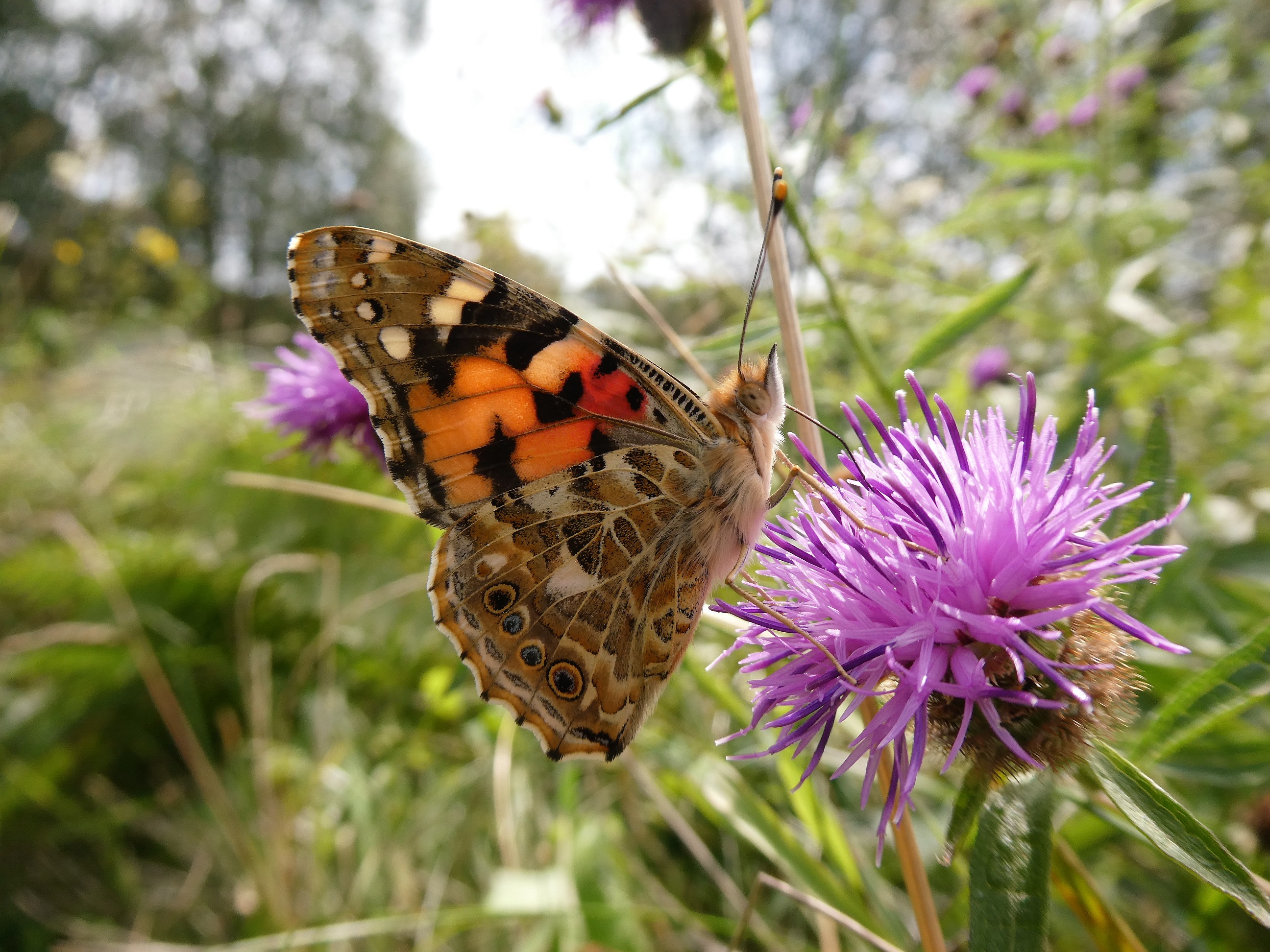 Painted Lady © J.Harding.
Painted Lady © J.Harding.
CONTENTS
• Introduction
•Butterfly of the Year
• Butterfly Season Report
• Events Report
• Crabtree Nature Reserve Report
• Conservation News
• Garden Survey Report
• An introduction to Moths
• Butterflies of the Balkans
• Royal Canal Citizen Science Project
INTRODUCTION
Dear Butterfly Conservation Ireland Member,
Welcome to Butterfly Conservation Ireland’s Annual Report 2019. The year 2019 saw more typical and less extreme weather conditions than 2018, with good weather conditions scattered across July, August and parts of September but without any prolonged period of very settled, sunny weather. Our reserves performed very well in 2019, thanks to your support and hard work put in by our volunteers. Our small staff are fortunate in having excellent support from our active membership whenever help is needed in these endeavours. Butterfly Conservation Ireland’s membership grew substantially in 2019, reflecting perhaps the growing concern, highlighted by the plight of many of our butterflies, for the environment generally. Your continued practical and financial support is greatly appreciated as we strive to ensure that our butterflies and moths continue to have an important voice for their conservation. Be assured that the conservation agenda is pursued at every opportunity. Our recording scheme received an enormous increase in records in 2019; let’s see if we can maintain this in 2020. Our financial accounts were approved so thanks are due to our joint treasurers Michael Jacob and Joseph Harding. Thanks are due to Richella Duggan and Pat Bell for help in editing this report and to all who contributed to its contents and to all of our members and supporters. We hope that you enjoy reading our Annual Report 2018 and we look forward to hearing from you in 2020.
Yours in nature,
Jesmond Harding (Secretary)
Butterfly House,
Butterfly Conservation Ireland,
Pagestown,
Maynooth,
County Kildare
BUTTERFLY OF THE YEAR 2019
If ever a year is remembered for a butterfly, 2019 must be deemed the Year of the Painted Lady. The butterfly captured the public imagination and commanded media attention. People who scarcely notice butterflies were captivated by the sheer scale of the butterfly’s abundance and records poured into Butterfly Conservation Ireland and to every organisation recording biodiversity. This article by Jesmond Harding introduces the butterfly, offers a brief history of its name and cultural importance, a synopsis of its migration to Ireland and a review of the migration events we experience in 2019.
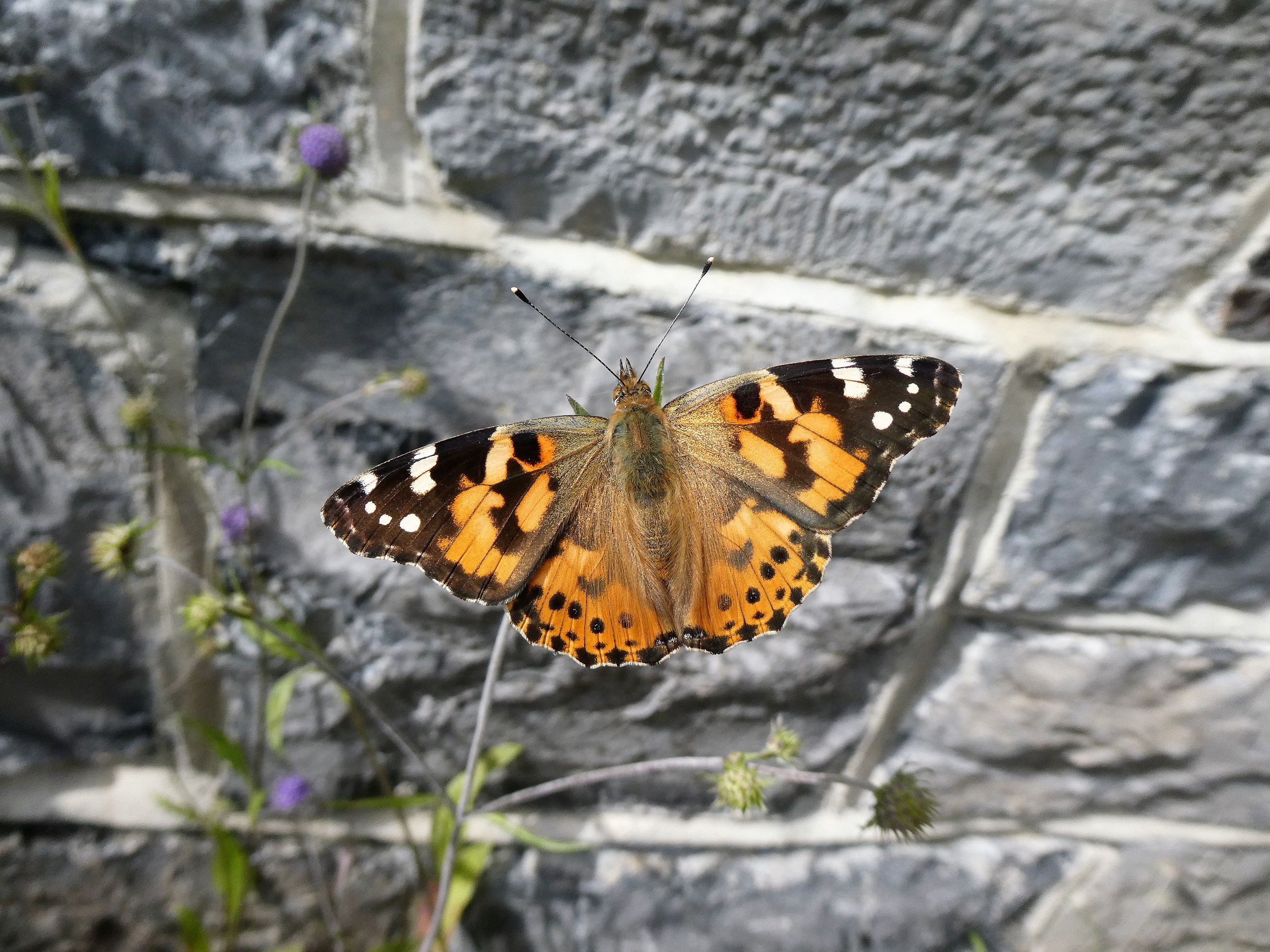 Painted Lady feeding prior to migration.
Painted Lady feeding prior to migration.
The Painted Lady, Vanessa cardui is one of the most widely distributed butterflies in the world and was well-known to early butterfly-lovers. James Petiver (c.1665-1718), a London-based collector, mounted specimens of this butterfly between sheets of mineral mica. Petiver first used the name Painted Lady in his record of the butterfly but the name may already have been in use. Appreciation of its beauty was reflected in its French name, La Belle Dame and in its Spanish name, Bella Dama o cardero, ‘the pretty lady of the thistles’. The Dutch appear to have been unimpressed, calling it Distelvlinder, the ‘Thistle Butterfly’. In Gaelic its name is Áilleán, meaning ‘beauty’. The butterfly may have had some deeper cultural resonance.
The Painted Lady is featured by Renaissance artist Albrecht Dürer in his 1504 masterpiece, The Adoration of the Magi, commissioned by Frederick the Wise, Elector of Saxony (a state of the Holy Roman Empire, Germany) for the church at Wittenberg. In the painting, a settled Painted Lady is perched on a millstone near what appears to be a female Clouded Yellow. These have been interpreted as symbolic of the risen Christ; the millstone a symbol of the stone of Christ’s empty tomb while the butterflies are an icon of the resurrection. This idea continues to exist, with people seeing butterflies on or near coffins as a symbol of hope.
A fresh specimen lives up to its French, Spanish, English and Irish names, with orange marbling on dark brown upper sides while a lovely salmon-pink band on the forewing underside stands out. While the Painted Lady butterfly is an annual migrant to Ireland it is very scarce here in some years, with perhaps only a single specimen seen by observers. The Painted Ladies that arrive in Ireland originate in North Africa and perhaps the Middle East. It usually appears in Ireland from May and persists until the end of September. Away from the south coast, the Painted Lady is very rarely recorded between the end of October and April. On settling in Ireland, egg-laying quickly follows. Given good weather, a home-grown generation develops and most if not all of this generation migrates southwards to breed as Ireland’s autumn closes in.
Years of extraordinary abundance occur when millions make the journey to Ireland and Britain. For example, 2009 was an exceptional year. In late May and early June that year, vast numbers arrived from central Spain to breeding grounds here. Butterfly Conservation Ireland’s Jesmond Harding was in Kinvara, a coastal village in south Galway at the end of May 2009 when he witnessed hundreds pour on to the main street from the sea. Some settled immediately on Red Valerian flowers growing in crevices in the stone wall along the coast, to drink after their long flight. Many settled on the road and were killed by traffic.
In very recent years, Painted Lady butterflies, usually reported as singles have been seen along the south coast in January. Then on January 10th 2019 Painted Lady butterflies were reported by Patrick Lyne as being “everywhere in the warm sunshine” on Fair Head, right at the coast, on the Beara peninsula in south-west Cork. The appearance of such numbers (20 at least were seen) in Ireland in January is perhaps unprecedented. The previous two weeks were unusually mild, which allowed this cold-susceptible butterfly to travel. A number of sightings were reported from various parts of Ireland in the rest of January and February 2019. Whether its arrival in the depths of winter heralds a change in the pattern of this butterfly’s appearance in Ireland will no doubt become clearer in the years ahead but it seems that climate change could be responsible for this unusual migration event.
Then in April, Butterfly Conservation Ireland member John Lovatt reported on a mass migration event that had just taken place in Cyprus. It is speculated that these came from Kuwait. John recounted: “On 21st March there was an invasion of Painted Ladies which one might liken to what might be expected with locusts. Clouds of butterflies arrived constantly all day. There were around 100 butterflies in front of me and the same number on both sides and behind me. To look beyond, the same numbers were everywhere as far as I could observe. I estimated at least a million on the Gkreko Head district and when at Paralimni about eight km. distant, there was a similar migration. I later learned at Nicosia there were unprecedented numbers there. This information came from a well-respected bird watcher. I later heard there were large numbers at Pafos, a two-hour drive away to the west. It must be reasonable to consider the large numbers were present all along the south coast and into the Turkish south coast on the panhandle to the east.
It was considered that five million butterflies in the whole Famagusta district to Nicosia would be a conservative estimate. This would only be section of the whole migration along all the coast.
Numbers continue to arrive but in much lower numbers of 30/300k daily up to the 8th April. On the 8th April there was another large invasion, but not like the 21st March, with perhaps a million estimated in the Gkreko district.
In all, it has been a remarkable experience that has amazed the population of Cyprus, not simply nature lovers”.
Butterfly enthusiasts in Ireland felt that there was a great chance that the offspring of the Painted Ladies that poured into Cyprus would head north later in the year, together with Painted Ladies that migrate to Spain from North Africa in spring.
In June and July, a heatwave struck Europe. This desiccated the foodplants of the Painted Lady caterpillars, making the vegetation unsuitable for breeding, driving the Painted Lady to cooler areas to the west and north where foodplants remained nutritious. Massive population accumulations in an area may also be behind population movements; some species form swarms when the population is very large and move together.
Near the end of June extending into early July, large numbers of Painted Lady appeared along our coasts and soon penetrated inland. Egg-laying on thistles was reported within sight of the sea at Howth, County Dublin on Ireland’s east coast. Many of the butterflies that arrived in late June and early July soon settled down and laid their eggs. These eggs resulted in a native generation of Painted Lady butterflies late in August.
However, at the end of July, the Painted Lady story took a new twist. A massive front made landfall in Scotland and along the Donegal coastline. From Tory Island, Grace Meenan described her experiences of seeing a huge number “like a carpet full of them, amazing to see!” The influx into Donegal was unusual in that there were no reports of the butterflies arriving in numbers along the south coast.
Then on August 1st, Sam Hanna from Kilteel near the County Down coast reported around 100 Painted Lady butterflies in his garden, feeding on verbena and lavender. It seems that the butterfly was arriving in numbers on both sides of the northern part of Ireland. A day or two later, Painted Ladies began to appear in number on the Dublin coast and elsewhere on the east coast. Then on 6th August Stephen Evans-Freke recorded hundreds of Painted Lady butterflies in his garden facing the ocean at Rathbarry Castle, Castle Freke, in County Cork. Large numbers were recorded from various parts of Ireland up to around August 15th. Afterwards, smaller numbers were reported, though consistently, along with several reports of larvae on thistles.
This pattern of mainly smaller but still impressive numbers was reported throughout September with one large exception of 228 from The Raven, County Wexford on 11th September, likely a pre-departure assembly. My own sightings during September were all of the freshly emerged butterflies, quite tame, feeding up for the long trek southwards. The latest date when good numbers were reported was 20th September, when over 60 were present at Lullymore/Lullybeg, County Kildare. Mainly singles were reported from 24th September, with just 12 Painted Ladies reported in October, the last one reported on 21st October in Wexford. The Painted Lady Year of 2019 had ended.
Typically, this mass migration happens once a decade. However, mass migration events took place in 2017, 2018 as well as in 2019 which, like 2009, was a truly remarkable year for the species. The arrival of large numbers of the Painted Lady in Cork and Kerry during January 2019 is striking. This suggests that the butterflies are signalling changes in their habitats and climate. Butterflies respond very swiftly to change, making them important indicators. It must be stressed that the Painted Lady is an exceptionally powerful butterfly, able to fly hundreds of miles to find the right conditions when the foodplants in an area fail. What about the less mobile butterflies that cannot move northwards, or whose foodplants occur only in the areas that may now be becoming unsuitable?
The year 2020 will be interesting for this species. Will we get a repeat? Overall, history suggests that this will not happen. But do let us know. For a valid record, send your name, date of sighting, the number of each species seen, a grid reference (see https://irish.gridreferencefinder.com/) and the place name and county to conservation.butterfly@gmail.com. All records are acknowledged.
BUTTERFLY SEASON REPORT 2019
We all knew that the magnificent summer of 2018 was a one-off, unlikely to be repeated in 2019 or any year soon. Yet 2019 had its moments too. If January was mild, some of February was balmy. We had an extraordinary period in February. I have not seen people in t-shirts in February in Ireland before but February 2019 was incredibly warm. The maximum temperature recorded was 17.3 Celsius on 25th February at Mount Dillion, County Roscommon. Temperatures of this level are more than enough to tempt butterflies over-wintering as adults to take flight and this they did. It felt surreal to stroll outside during lunch break in February and routinely observe Small Tortoiseshells and Peacocks feeding on flowering dandelions. Even more remarkable was the flight of Brimstones, a species that flies only when it is both warm and sunny. Nine were seen by Pat Wyse at Lullymore on February 25th. By the 27th, records of Brimstone, Red Admiral, Painted Lady (including a remarkably early January influx in Kerry), Small Tortoiseshell, Peacock and Comma (seven seen in Mount Usher Gardens, Wicklow) had been received, a stunning and extremely early start to the season.
The season was in danger of over-heating with too many butterflies looking for too little food. March cooled the season’s ardour, typically, and put us back in coats and butterflies back undercover. Rain and wind followed but in the last week, spring returned. The temperature reached a peak of 17.7 Celsius on 20th March at Phoenix Park. The Holly Blue (26th March), Green-veined White (29th March), Orange-tip and Speckled Wood (26th March) were first seen in March. The first Orange-tip was seen on 29th March, a very significant record. This March Orange-tip record is a rarity in Ireland. The average first sighting date for the Orange-tip during 2013-2017 (5 years) for this website is April 10th. The average date for the period 2007-2017 for Britain is March 19th. March Orange-tips were extremely rare in Britain before 1989. The earlier first emergence dates for this butterfly correspond with warmer temperatures, particularly over the past 22 years.
April was in and out with rain succeeded by sunshine over the month. The highest temperature reached was 22.9 Celsius on 20th March recorded in Oak Park, County Carlow. The Large White (19th April), Small White (6th April), Green Hairstreak (21st April) and Wall Brown (18th April) were first seen in April. While there were some high numbers of individual butterflies recorded, such as 42 butterflies counted by Robert Aldwell and Niamh Lennon on 18th April at Mount Usher Gardens, County Wicklow, it was turning out not to be a particularly early season for butterflies that emerge in spring. For example, there was no April record for Cryptic Wood White, Wood White, Dingy Skipper, Common Blue, Pearl-bordered Fritillary or Small Heath.
All of these species were recorded for the first time in 2019 during May. All six were recorded by 15th May along with Small Blue on 3rd May and Small Copper on 10th May, reported from Donegal by Maurice Simms and by Robert Aldwell and Ethna Diver respectively. May was not especially warm but until the last week was fairly dry. The highest temperature recorded was 21.9 Celsius, lower than April’s peak temperature record. A butterfly we were keen to check on during 2019 was the Green-veined White. This breeds on wetland plants which makes it vulnerable to prolonged drought. While it appeared in reasonable numbers during May, these were far lower than in 2018. For example, the peak number seen at one time in 2018 was 150, by John Lovatt on 26th May.
In 2019 the highest number seen at once was 18 counted by David McIlveen on 21st May at Milford, County Donegal. The large drop in its population was reflected throughout its flight period during 2019. One species that did really well in 2019 is the day-flying Narrow-bordered Bee Hawkmoth which flew from 5th May to 30th June. It was appearing in areas it was not known from before, such as Windy Gap, Cooley Mountains, County Louth where Enda and Ciaran Flynn found it. The butterfly the Narrow-bordered Bee Hawkmoth shares its habitat and larval foodplant with, the Marsh Fritillary, was seen first by Ian Whiteside at Lullymore/Lullybeg on 21st May. The species did well enough in 2019, despite the awful weather during much of June. I saw it several times during the period of bad June weather and saw how it is remarkably good at getting its vital life cycle events done in the brief snatches of sunshine and good ambient temperature. It certainly needs this ability in Ireland.
The first three weeks of June were cold, wet and poor for butterfly watching. The first Meadow Brown record had to wait until June 10th (Frank Smyth, Sutton, Dublin) while the second record was on 15th June (Kildare) the third on 18th June (Donegal), all single individuals. The first Large Heath was recorded on 11th June on Clara Bog, Offaly by Niamh Lennon. The first Ringlet was seen by Jesmond Harding at Lullybeg, County Kildare. These records were on days with some sunshine, mainly brief sunny intervals in a cold June. It looked like the summer might be washed away. Thankfully, late June saw an improvement and summer’s hottest day, June 27th when Shannon reported 28.4 Celsius. It was in late June that the first Dark Green Fritillaries were seen, by Jesmond Harding on Lullybeg, County Kildare and by Maurice Simms, Leslie and Andrew Whiteside in beautiful Sheskinmore, County Donegal. In some years the Dark Green Fritillary is first seen at the beginning of June. Jamie Bliss reported the first Graylings on 27th June, from Rinmore and Sessiagh, County Donegal.
One feature that was beginning to create a media stir was the appearance of large numbers of the migrant Painted Lady. There was only a single record in May but on 24th June they began to appear in good numbers, suggesting that a large migration event was underway. The butterflies were being reported from various locations-Cork, Donegal, Kildare, Wicklow, Dublin-suggesting migration along a broad front. Myrtle Parker reported 60 from Minane Bridge, County Cork on 30th June. This was the largest 2019 record up to that date. The influx, while impressive was not enormous, certainly nothing like the mass migration in late May/early June 2009. The run of sightings petered out early in the second week in July. This turned out to be a pause.
July had mixed weather-sunshine, rain, sometimes heavy and above-average temperatures. The highest temperature was 26.2 Celsius on 22nd July, recorded in the Phoenix Park, Dublin. The first Small Skippers were seen on Drehid Bog, County Kildare on 1st July by Pat Wyse. Pat saw 26 Small Skippers on 24th July. The species seems to be stable on this site. The first Silver-washed Fritillary showed himself on 2nd July at Lullybeg. James Noonan saw the Essex Skipper for the first time on 4th July at its Killinick stronghold in County Wexford. A butterfly that needed to be monitored after the 2018 drought, the Ringlet, did very well in 2019. This grass breeder is believed to be at risk under a climate change scenario of drier, hotter summers but, if anything, it did better in 2019. This might be due to the fact that it breeds in areas that are damp and often partially shaded, buffering it against prolonged dryness. The Purple Hairstreak was first reported on 15th July by Sean Geraty from the Phoenix Park, Dublin. Happily, Eddie Gilligan found it in Leixlip, County Kildare, the first time it has been reliably reported from the county. Ian Rippey then discovered the butterfly at Belturbet, in Cavan along with the Red-tipped Clearwing moth; both were unknown in the county previously. While we did not see any report of remarkable numbers of the Purple Hairstreak as we did in 2018, there is no reason to doubt that it is still stable.
Another remarkable feature of July 2019 was the overlap in Brimstone generations noted at Lullybeg where an individual from the 2018 generation was seen after newly emerged Brimstones were first sighted. This shows the remarkable longevity of this lovely butterfly. July 22nd saw the first newly hatched Peacock of 2019. At the end of July, a remarkable migration event took place. On 30th July 172 Painted Ladies were reported by a number of recorders; the following day several hundred were reported by one recorder, Grace Meenan, from Tory Island, County Donegal. Over 200 other Painted Ladies were reported by other recorders on that day. Egg-laying and larvae were also being reported, promising a large emergence in August and September.
August is typically a month of heavy rain and August 2019 was typical. Rainfall was above average almost everywhere and there were a number of storms. It was mild with temperatures above average in most places. August 2nd had the month’s highest temperature, 25.4 Celsius (Mount Dillon, Roscommon). The earliest that the Brown Hairstreak was found was 3rd August by Jesmond Harding and Susan Reddin at Gortlecka, County Clare. On 4th August second generation Wall Browns were seen at Clooncoose, County Clare while at Fahee North 17 Small Heaths and nine Graylings were seen. Most Small Heath records were from June and July; it is interesting to see so many on one small site in August. A butterfly that appears to be in real trouble in Ireland, the Hedge Brown/Gatekeeper, was first recorded on 8th August in Dromcarra North near Kilmichael, County Cork by Ian Rippey. Ian found a total of 20-30 at two other Cork locations that day. The only other record was of two at The Raven, County Wexford, reported by Sean Geraty, on 11th August. The species may be about to disappear at The Raven and therefore from Wexford (probably), an indictment of the failure of the National Parks and Wildlife Service to manage The Raven for this beautiful satyrid.
Second generation Holly and Common Blues, Large, Small and Green-veined Whites were out by mid-August but none in the same numbers as 2018. The first Clouded Yellow was seen on 15th August at Ballyteigue Burrow Beach, Wexford by Seán Feehan. Red Admirals were appearing, in lower numbers than in 2018 but still widespread. Small Tortoiseshells and Commas were being reported from about mid-August. There were 293 records of the Peacock in 2019, up from 221 in 2018. Most of these were from August; 150 were recorded by Jesmond Harding at Lullymore/Lullybeg on 24th August. Frank Smyth saw 76 Peacocks at Knather Wood, County Donegal on 29th August. It had a good year. Of this more at the report’s conclusion.
September is a highly erratic month for weather and a month of dramatic change for butterflies. The month was mild, wet and sunny with some really beautiful weather at times, especially on the 3rd, 19th and 20th September (the peak temperature was 22.1 Celsius on 3rd (Moore Park, Cork) and 19th (Athenry, Galway)). As for the butterflies, the month opens with as many as 24 species on the wing. It closes with around 15 species still in flight but in greatly reduced numbers. The Painted Lady butterflies were emerging from pupae and large numbers of beautifully fresh specimens were reported from throughout the land. One notable record was of 228 at The Raven on 11th September (Sean Geraty). The month ended typically with numbers and range of species much diminished. A late highlight was four Commas seen by Michael Kane at Tomsollagh, Ferns, County Wexford on 29th September.
October was cool and wet. The highest temperature was just 17.7 Celsius reached at Oak Park, Carlow on the 7st October. There were many records of Red Admirals (including breeding at Howth-Frank Smyth) and to a lesser extent, Painted Lady, Small Tortoiseshell, Peacock, Holly Blue, Small White, Green-veined White and even of two Brimstone at Lullymore on 16th October (Fionnuala Parnell).
November was a cool, wet and dull month (the top temperature was 14.9 Celsius at Moore Park, Cork on 1st November). Only ten individual butterflies were reported. Nine were Red Admirals, one was a Peacock. Finally, after 50 days without a butterfly sighting, a Peacock was seen by Jesmond Harding in his County Meath garden on New Year’s Eve, at 1:40 pm, basking in the winter sunshine. The year ended as it began; the first butterfly of 2019 was a Peacock basking at Ardara, Donegal (Ann Cannon) on January 1st.
EVENT REPORTS 2019
Butterfly Conservation Ireland holds events for members every year. Here are reports of the events held in 2019. These were posted on the website following each event.
February 16th 2019. Event Report: Lullybeg Management Day
Butterfly Conservation Ireland’s first event of 2019 which took place on Saturday 16th February enjoyed the benefits of dry, mild breezy conditions at Lullybeg’s Crabtree Reserve. Our members took on a section on the southern end of the reserve where re-growth from a cutting that we made about four years ago was tackled.
This main habitats in the area are poor fen and dry/humid grassland. The fen area is rich in mosses and Ragged Robin, a lovely flower seen in bloom in early summer. The grassy areas are rich in fine grasses with a smaller area of dense, rough grassland containing Purple Moor-grass. Two years ago, the Marsh Fritillary moved in to breed in this area. Small Heath favours the finer grassland. This humble little butterfly has been in decline on the reserve for the last five years so this action of restoring open grassland is a necessary step, along with the grazing on a section of the northern side of the reserve last autumn. The fortunes of the butterfly will be carefully monitored in the coming months.
We managed to cut down to ground level all the sprouting scrub, leaving open grassland. It was hard work and we stopped for lunch to relax and catch up on each other’s news and views. Conservation is a good social as well as physical activity! Over the flight season, a weekly count will be taken at the cleared section as it represents section one of the transect that is run on the site. A report of the effects of this management will appear later in 2019.
On behalf of all our members and supporters, a special thank you for all who worked so hard on the site. Nature will thank us too in the months ahead.
May 18th 2019 Event Report: Bull Island Visit
Leaden skies with some bright patches offered hope for at least a dry spell for our Bull Island outing today. We assembled at the roundabout (luckily, I brought my net as an identification point!) and headed north along a sandy track. Deep pink Common Vetch and splashes of buttercup flowers gave a sharp contrast against the muted green of the wall of grasses that edges the path but little else was in bloom.
We reached the ‘Alder marsh’, which was very dry, and soon Marsh Fritillary larvae were observed. These were fully grown and sluggish or stationary. Most were on dry grass, some on the foodplant, the Devil’s-bit Scabious. Most of the larvae will have pupated and a few adult butterflies may have emerged but the sun needed to coax any that have reached adulthood did not appear. The larvae remaining are most likely infected by a parasitoid wasp that prolongs the larval stage so that the wasp can delay its own emergence to coincide with the availability of the next generation of Marsh Fritillary larvae which will be present after mid-July. We eventually found a chrysalis, in the open, attached to the upper surface of a foodplant leaf (an untypical pupation site). A Drinker Moth larva, a Common Lizard and a delightful and stunning Cinnabar Moth were found. We managed to place the moth it in a jar where it eventually settled for a photo shoot!
It would have been wonderful to see the beautifully patterned adults but we might see them next weekend at Lullymore. It was a lovely day for conversation and it was lovely to be in such a warm and engaging company. The constant singing of the skylarks provided a delightful atmosphere. The view from the marsh looking northwards to Howth is uninterrupted rural Dublin at its finest. You’d never think the capital city is just behind you! Thank you for everyone who joined our outing and made it special.
May 24th and May 25th 2019 Event Report: Lullymore Moth Morning and Butterfly Walk
Lepidoptera events depend on the right weather and moth-trapping is no exception While butterflies need direct sunshine, most moths are nocturnal and overcast nights are what these moths prefer. Even heavy rain will not deter moths provided the night is mild.
Fortunately for our efforts to trap moths (under licence from the National Parks and Wildlife Service), Friday night was calm and mild and when we arrived to open the traps on Saturday morning, we were rewarded with a great range of species and great numbers. Philip Strickland, Butterfly Conservation Ireland’s moth specialist identified the moths, including the tiny micro-moths. Among the species were Fox Moth, Emperor moth, Eyed Hawkmoth, Poplar Hawkmoth, Lesser Swallow Prominent, Pebble Hook-tip, Scalloped Hook-tip, Green Silver-lines, a rather late Common Quaker and Clouded Drab, a lovely Lunar Thorn, Muslin moths, Grey Pine, Spruce, Broken-barred and Green Carpets, to name a few. Some quite scarce species, such as Grey Birch, of which there were around six individuals, also featured. The Beautiful Snouts looked perfect, almost as if they were smartly and formally attired for an official engagement.
We got plenty of photographs especially of the larger moths, most of these proving very docile. While butterflies are so obviously striking and easy to see and admire, moths are just as elegant but harder to find. It is great to see the pleasure the moths’ beauty gave to everyone present and although this has been said on this website many times before, it is the people who attend our events who render the experience of nature even more special. Hearing the views of people regarding a moth or butterfly they have seen for the first time offers new insights and fresh excitement. For those who are familiar with a particular species, the excitement of another’s discovery refreshes enthusiasm, imbuing the familiar with new wonder.
After adjourning to the Heritage Park cafe for refreshments we set out for famous Lullymore West cutover bog to check the day-flyers. Alas, the sun was lacking; it was damp and seemed unpromising. However, careful searching did yield some good results. While not very active, we saw a number of diurnal moths and perched butterflies. Marsh Fritillary, Cryptic Wood White and Narrow-bordered Bee Hawkmoth were highlights. We thank everyone who attended. I hope everyone enjoyed the experience as much as we did.
June 8th 2019 Event Report: Outing to Clongawny, Westmeath
Clongawny is just outside Mullingar, not far from the N4. The visited sites lie north and south of the Royal Canal and are quite different. One is calcareous grassland on the steep bank above the canal while the other is a low-lying area of wet, boggy grassland.
We met at the car park near the high bank and set off for the damp grassland first; it is very exposed offering no shelter against the expected rain shower. We needed to catch the sun while we had it. The site was discovered to hold a large Marsh Fritillary colony two years ago. Local Butterfly Conservation Ireland members Lesley Whiteside and Richella Duggan monitor the site. Some scrub was cut and an invasive grass, Reed Canary-grass, was mechanically controlled. Waterways Ireland were notified and an agreement reached that the site’s main nectar resource area would not be mown during the Marsh Fritillary flight period.
Our group consisted of around 20 people ranging from the very young to the young at heart-great to see interest in nature shared across the demographic! We walked on the main track through the site and Marsh Fritillaries soon zoomed in-and-out- of view. Males are tricky to follow in flight as they are very active in the sunshine, darting erratically across the grassland, plummeting when a stiff blast of blustery wind pushes it back. Fortune favoured close inspection-the sun was intermittent causing males to land and bask on vegetation. Phones, as well as cameras, were used to take photographs. Some butterflies quietly perched on hands when encouraged, offering great close-ups of this highly local species. A few Cryptic Wood Whites fluttered laboriously around the site, occasionally pestered by urgent fritillaries. There was not much in flower for the butterflies to feed on. A few tiny tormentils, buttercups and a few clumps of Kingcup (the first time I’ve seen this fritillary use the plant) were really all there was but the butterflies were active regardless.
After we walked the site, we rejoined the towpath and continued east for around 150 metres and entered the edge of the local bog. Here there is a transition zone between raised bog and damp grassland that contains an obvious abundance of Devil’s-bit Scabious and, in the driest areas, Common Bird’s-foot-trefoil. Patches of scrub provide shelter. A really dense colony of Marsh Fritillary was found here. Common Blue, Burnet Companion moth and Common Heath were recorded too. The frenetic activity of the Marsh Fritillary here created great interest.
But we re-traced our steps to get our lunch. Lesley’s delicious cookies were delicious! Hot tea and cookies fortified us for the high bank which is awash with vetches, trefoil, hawkbits, orchids and in parts, Kidney Vetch, a rare plant in this area. The sunny track here is great for Dingy Skipper, Common Blue and Cryptic Wood White. We enjoyed watching a lovely ‘blue’ female lay on Common Bird’s-foot-trefoil before darting decisively down the track to seek, no doubt, fresh breeding ground.
We then headed home, happy that the Marsh Fritillary is still in the Mullingar area 117 years after it was reported as a local plague! It is very unlikely we will ever see mass populations again given the damage done to the natural landscape but at least we know where to find the species, and we have local people who care for the butterfly and take the steps needed to keep the butterfly happy.
A special thanks to the event organisers and everyone who came to the event, and in particular to the Baltrasna Environmental Group who take such care of and pride in their wild places.
August 12th 2019: Event Report: Burren Walk
Our Burren walk on Sunday, August 4th met on the Green Road just past the turn for the Lough Avalla Loop Walk. The weather was very inclement. It rained very heavily within the hour before our start time of 2 pm. It offered the prospect of a wash-out.
We parked in a field and assembled. Would there be anything to see? An introductory talk on the Burren’s butterflies was followed by showing some moth specimens trapped at Carran the previous night and a Grayling caught in the morning sunshine and a beautiful male Wall Brown fortuitously caught in the field before the walk. Moths shown were the Dark Spectacle which was well-received-seen head-on, pale tufts resemble eye-glasses, creating amusement in our group. A yellow Scalloped Oak well-named for its scalloped edges but not for the oak which it does not resemble. Oak is a larval foodplant for the moth. The Burren Green was a star, though, living up to its name by being a green moth confined to the Burren. The moth settled happily on one lady’s coat and refused to depart.
We proceeded to the nettle patch near the field edge. The nettles were very vigorous with hundreds of Small Tortoiseshell caterpillars from at least three growth stages (instars). Folded leaves were opened to show a solitary Red Admiral larva in each one. A thistle patch held Painted Lady caterpillars, feeding as quietly as the Red Admirals. The larvae and their behaviour received great attention from our enthusiastic group. The open feeding habits of the Small Tortoiseshell larva contrast sharply with the solitary, well-concealed strategy of its relatives-why is this? Do the Small Tortoiseshells need to bask openly to digest food? Are the softer-bodied Red Admiral and Painted Lady larvae more susceptible to bird attacks or being stung by parasitoid wasps? These are possible reasons for the different living arrangements.
A Ringlet and Meadow Brown butterfly were spotted and closely approached, their eye-spots providing a ready definer as members of the “brown” family. The placement of spots around or near wing edges deflects bird attacks away from the vulnerable head allowing the butterfly to escape with just a nip to the wing edge.
About an hour and forty minutes into our event, the swollen clouds burst. Thanks to the Burrenbeo Trust who helped to organise the well-attended event.
October 26th 2019: Event Report: Lullybeg Management Day
A cool, sunny day on Saturday 26th of October made for very pleasant working conditions on our Kildare reserve. An enthusiastic group tackled scrub re-growth from around five years previously. The area we worked on has breeding habitat for Brimstone, Marsh Fritillary, Dark Green Fritillary and Wood Tiger among several other species. The area has a mosaic of habitats packed into a small area attractive to a diverse range of species with very different foodplants and specific micro-habitat needs.
We took a number of steps to cater for all these species. Dense willow and dense birch were cut down but two tree species growing among the birch and willow-Alder Buckthorn and Purging Buckthorn, the foodplants for the larva of the Brimstone butterfly and Holly Blue butterfly were identified and spared. The buckthorns now have more light around them. This makes them more suitable as breeding plants.
By clearing and removing the scrub, we made Common Dog Violet plants, used for breeding by the Dark Green Fritillary butterfly, open to the light. Rough vegetation near the violets was preserved so that the caterpillars will have areas to hide in and to bask on during sunny weather next spring.
Another issue to deal with was a flush of birch saplings. These threaten to out-compete St John’s Wort used by the Wood Tiger caterpillars and Devil’s-bit Scabious used by the caterpillars of the Narrow-bordered Bee Hawkmoth and Marsh Fritillary butterfly. We uprooted these, which yielded readily due to the soft soil.
All uprooted and cut material was placed in a pile to the north to avoid casting a shadow on breeding areas. It was heartening to step back and look at what we achieved and we know our butterflies and moths will thank us for it!
As usual, we had great conversations about a range of subjects, enjoyed the food we brought and shared. Conservation is about people too!
CRABTREE RESERVE REPORT 2019
| Species Recorded | Average Site Total 2011-2017
(LTA)* |
Site Total 2019 | Site Total 2019 – Average Site Total 2011-17 | Average
Transect Total** 2011-2017 (LTA)* |
Transect Total** 2019 | Transect Total 2019 – Average Transect Total** 2011-17 |
| Dingy Skipper | 24.7 | 10 | -14.7 | 23.6 | 9 | -14.6 |
| Brimstone | 44 | 102 | 58 | 20 | 46 | 26 |
| Cryptic Wood White | 4.6 | 9 | 4.4 | 3.4 | 7 | 3.6 |
| Green-veined White | 46.4 | 6 | -40.4 | 35.4 | 3 | -32.4 |
| Orange-tip | 17.6 | 7 | -8.6 | 12.8 | 6 | -6.8 |
| Large White | 0.86 | 0 | 10.44 | 0.6 | 0 | -0.6 |
| Small White | 9.1 | 4 | -5.10 | 7.4 | 4 | -3.4 |
| Common Blue | 54 | 44 | -10 | 48.6 | 36 | -12.6 |
| Small Copper | 15 | 15 | 0 | 5.7 | 10 | 4.3 |
| Red Admiral | 42 | 65 | 23 | 18.7 | 25 | 6.3 |
| Painted Lady | 17 | 260 | 243 | 9.5 | 174 | 164.5 |
| Small Tortoiseshell | 165.7 | 206 | 94.3 | 105.8 | 145 | 39.2 |
| Peacock | 151.8 | 319 | 167.2 | 68.8 | 224 | 155.20 |
| Comma | 0 | 1 | 1 | 1 | ||
| Dark Green Fritillary | 1.5 | 27 | 25.5 | 1.5 | 19 | 17.5 |
| Silver-washed Fritillary | 9.3 | 28 | 18.7 | 3.7 | 19 | 15.30 |
| Marsh Fritillary | 56 | 80 | 24 | 23 | 44 | 21 |
| Wall | 1.5 | 0 | -1.5 | 0.9 | 0 | -0.9 |
| Speckled Wood | 31.6 | 35 | 3.4 | 9.3 | 22 | 12.7 |
| Meadow Brown | 167 | 401 | 234 | 125.7 | 325 | 199.3 |
| Ringlet | 340 | 1423 | 1083 | 251 | 993 | 742 |
| Small Heath | 130 | 57 | -73 | 106 | 53 | -53 |
| Large Heath | 0.3 | 0 | -0.3 | 0.3 | 0 | -0.3 |
| Total | 1330 | 3099 | 1835 | 882 | 1592 | 1285 |
*LTA=Long- term average
**Transect totals based on an average of 24 counts for LTA and on 24 counts in 2019
The butterflies on Butterfly Conservation Ireland’s Crabtree Reserve at Lullybeg are counted by walking the transect route on part of the reserve from April to the end of September and in October if conditions favour butterfly activity. Results are sent to the National Biodiversity Data Centre. Butterflies seen outside the transect route are counted separately. Both counts are reflected in the table above. The average figures for the period 2011-2017 are compared against the 2019 figures.
Most of the butterflies that fly chiefly in April and May except for the Cryptic Wood White and Brimstone (the Brimstone also flies in summer and autumn) were below the long-term average (LTA). This can be explained by erratic weather in April and somewhat cool weather in May. The transect was walked in only five weeks out of a possible nine during these months, mainly because the weather was unfavourable. Special mention needs to be made of the Brimstone’s rise. In 2019, 102 were seen, a huge increase on the LTA of 44. This great increase is linked to the management undertaken, involving clearing scrub to reveal previously shaded buckthorn plants, the larval foodplants of the Brimstone. Buckthorns have also been planted to increase the food supply. The Marsh Fritillary was recorded at significantly above the LTA. This was due to the excellent conditions in May and June 2018 when at least 40 larval nests were found. Despite poor June weather, 80 adults were found on the site. However, only 26 larval nests were found in autumn 2019, although most were large. It will be interesting to see how many adults are seen in 2020.
Large and Small Whites showed a decline in 2019 but should rise when their overall populations increase. Small Copper showed no change but Common Blue numbers are down on the LTA but Red Admiral, which had a poor year in Ireland in 2018, increased in 2019 and is above the LTA. The Painted Lady, a close relative, had a great year. The Wall Brown was not recorded, a decline reflected across much of Ireland in the past three decades, especially inland and in northern parts of Ireland, except for Donegal. The Large Heath was also unrecorded in 2019, but this butterfly’s status on the site is that of a vagrant. The serious worry is the drop in the population of the Small Heath. The butterfly has been falling in number on the site over the previous four years and while there was a small rise of two individual butterflies in 2018, the overall trend is one of steady decline. For example, the overall site totals from 2013 to 2018 are: 231, 229, 131, 62, 61 and 63. In 2019 57 were observed.
The Ringlet showed in great abundance, surpassing the LTA figure by 1083 individuals. The Meadow Brown also showed a high increase on previous years. The Speckled Wood showed a more modest rise.
Other big upward movers on the LTA are the mid-summer flyers. Although the Silver-washed Fritillary and Dark Green Fritillary were slightly down on the 2018 numbers, the table shows healthy rises for both, especially the Dark Green Fritillary which died out on the site around 2010. A concerted attempt to provide for it was made. Several Common Dog-violet, the larval host-plant were planted in 2011 and dense scrub was partly cleared to bring light to existing violet plants. In 2015 a small number of adult butterflies were released on the site. It has continued to build its numbers since. The Peacock and Small Tortoiseshell performed better in 2019 than the LTA.
A lovely surprise in 2019 was the arrival of the Comma on the reserve. It has everything it needs here. We hope to find it breeding on the reserve in 2020.
We plan to do some further management using heavy machinery in 2020. This work will include disturbing the soil to create basking sites and increase the temperature around nearby larval foodplants. Some scrub control will be used to maintain the grassland. Thanks again to all who helped in any way to monitor and manage this important reserve, the best-managed butterfly reserve in Ireland.
Jesmond Harding.
CONSERVATION NEWS
In February and November 2019, a Butterfly Conservation Ireland (BCI) work party cleared scrub on grassland at Lullybeg to create the conditions needed for the Marsh Fritillary, Dingy Skipper and Brimstone. Scrub on the broad ride through woodland connecting Lullymore and Lullybeg was also cut back to ensure that the two excellent areas remain linked so that butterfly populations in the area do not become isolated. Machinery from Lullymore Farm cut back an extensive area of scrub on the northern edge of the reserve which allowed flora to bloom which was used as a feeding area by butterflies, especially Peacock and Painted Lady.
Our recording scheme begun in 2013 continued in 2019. A great increase in records was noted.
Our online platforms were used to promote conservation throughout 2019. Various blogs were written to draw attention to butterfly and moth species that may be seen at the various times of the year, to conservation measures one can take to enhance gardens and public spaces for butterflies, to promote recording, to comment on findings of various reports on butterfly and moth populations and to report on Butterfly Conservation Ireland outings. Our Facebook page presents very attractive images sent in by members and by the general public, as well as publicising our work/events. Radio interviews on butterflies were given. Articles were written for the print media (including the Irish Times) concerning the Painted Lady migration events, increasing awareness of butterflies in general and putting forward conservation suggestions. Conservation and habitat enhancement advice was provided to a range of bodies and members of the public
In 2019 BCI objected to a proposed solar farm on Drehid Bog, County Kildare. This development would have caused serious damage to very good habitat for some rare species. A mitigation plan and a Lepidoptera Management Plan was developed with the consultants engaged by the applicants. Kildare County Council refused permission because wet heath was to be drained. Butterfly Conservation Ireland subsequently objected to the applicants’ appeal to An Bord Pleanala. BCI called for the Lepidoptera Management Plan to be implemented and for the appeal to be rejected on the grounds that the habitat destruction was unnecessary and that an alternative and far more suitable site for the solar farm exists. This decision is pending.
BCI members have continued to work hard, organising and carrying out recording, participating in practical conservation work and, very importantly, enjoying our butterfly and moth heritage.
In 2019 Butterfly Conservation Ireland monitored the Small Blue populations we introduced to coastal sites in County Meath and County Louth. The Small Blue is a threatened species in Ireland, rated ‘Endangered’. It is thriving on its Meath site, having occupied almost all the available habitat since its introduction in 2014. Its progress in Louth where it was first introduced in 2018 is unclear as yet but it bred successfully there in 2018 and 2019.
Please continue your recording and conservation work in 2020; no matter how small your work may seem you can make a difference. Some man-made habitats, such as gardens, often contain a greater range of biodiversity than semi-natural habitats because of the diversity of habitats and micromanagement possible in a garden.
Finally, Butterfly Conservation Ireland thanks everyone who helped with our conservation work in 2020. Conservation is a battle for the preservation of everything that is good about our natural world and we greatly appreciate your commitment to the most elegant emblems of our natural heritage, our butterflies and moths.
Jesmond Harding.
GARDEN SURVEY REPORT 2019
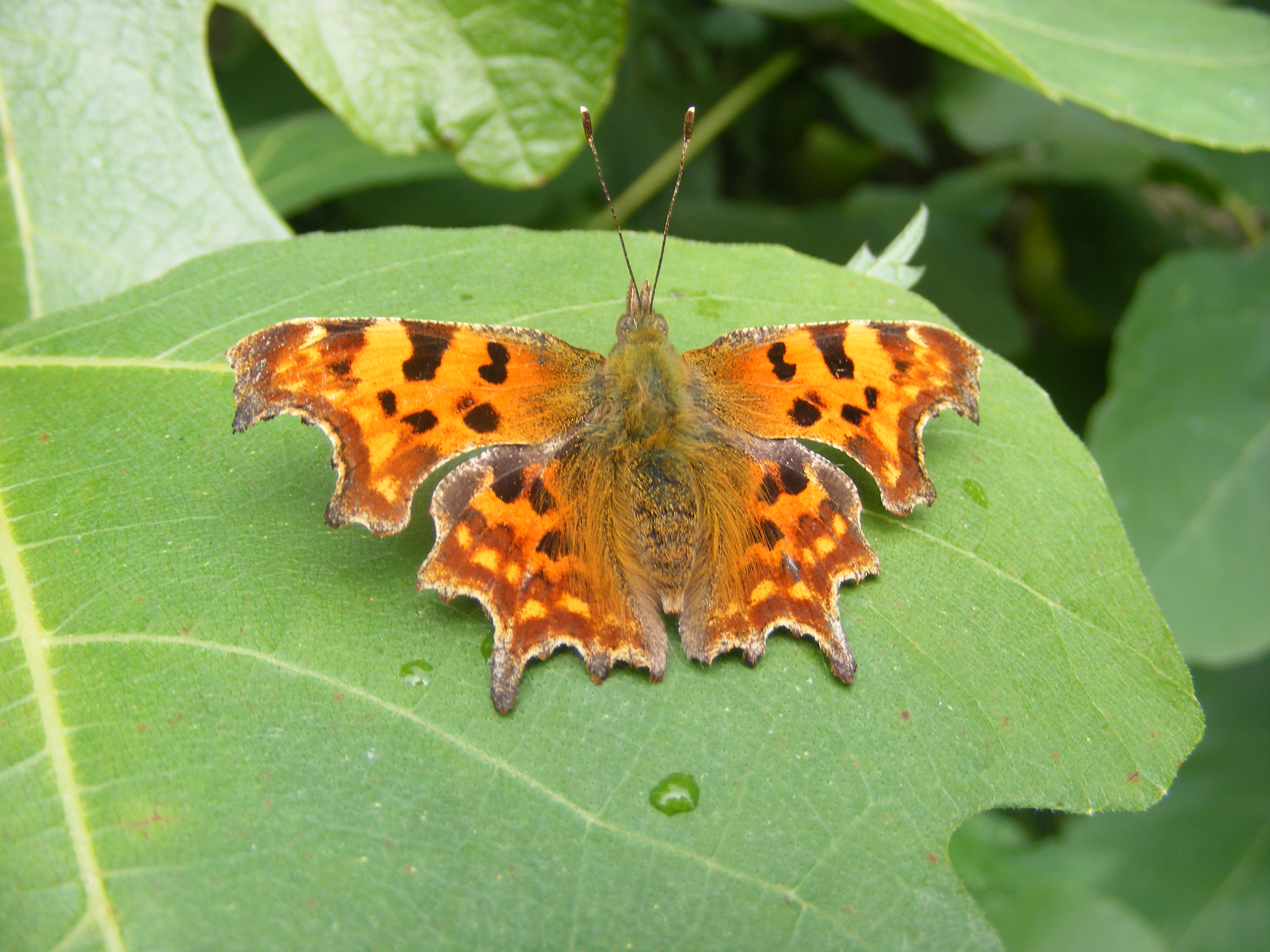 Comma basking on a fig leaf in Pat Bell’s garden, Maynooth, Kildare. Photo © P. Bell.
Comma basking on a fig leaf in Pat Bell’s garden, Maynooth, Kildare. Photo © P. Bell.
Butterfly Conservation Ireland members and members of the public participated in our garden survey from March to November inclusive. The survey form, available as a download from our website www.butterflyconservation.ie and available by post on request asks the participant to record the first date each butterfly listed on the form was first recorded in their garden in each of the following three-month periods: March-May, June-August and September-November. In a final column, the highest number of each butterfly seen and the peak date is given. Finally, surveyors are asked to indicate which of the following attractants are provided in their gardens: Buddleia, butterfly nectar plants other than Buddleia and larval food plants. Twenty butterflies are listed for recording. The following report comments on the 2019 flight season, outlines the status of these butterflies in gardens during 2019, offers interpretations and comments on the findings and concludes by urging conservation and involvement in recording garden butterflies.
Some very high numbers were reported; the highest number of butterflies recorded in one day in 2019 was 150, in the garden of Robert Donnelly in Ballyknock, in County Kilkenny on 26th August. In 2018 the highest was 124 (also in Robert’s garden), in 2017 the highest was 28, 25 in 2016 and 50 butterflies on one date in 2014. Jesmond Harding, recorded 352 individuals in his County Meath garden during the survey. Marilyn Farrell from County Kerry, a new garden recorder returned an excellent total of 554 butterflies during the survey period. Marilyn’s garden was featured in our Gardening for Butterflies feature published on the Butterfly Conservation Ireland website on 3rd September (https://butterflyconservation.ie/wp/2019/09/03/gardening-for-butterflies-2/). August saw the highest numbers. The first week of September was very good with some of the highest counts of the year. Conditions were excellent at times during the second and third weeks in September with 20th of September being especially warm and sunny.
The total number of species recorded in the gardens surveyed was 18, as it was in 2018. This is up from 15 in 2017, up on 14 in 2015 and 2016, and up one from 17 in 2014. The Small White, Painted Lady, Small Tortoiseshell and Peacock were recorded in all gardens while the Holly Blue, a species that likes to breed in gardens was reported by all but one surveyor (a big change on 2018); Richella Duggan in Westmeath reported her first garden record of the species. Michael Gray in Rathfarnham, Dublin counted 40 Holly Blues over the course of the survey (see Michael’s garden at https://butterflyconservation.ie/wp/2019/09/03/gardening-for-butterflies-2/) while Elaine Mullins from Portmarnock submitted 62 records of the butterfly, down from 106 in 2018. The species with the highest number of individuals recorded on a single day is the Small Tortoiseshell, with 105 recorded by Robert Donnelly. The lowest number of records were for the Silver-washed Fritillary and Clouded Yellow (two records).
The Large White fared less well than in 2018 but there were still some high counts. Robert Donnelly reported 12 on July 22nd; this was Robert’s peak date for the species in 2018 too. Elaine Mullins recorded 60, down from 98 Large Whites in 2018.
The brood structure of the Holly Blue which readily breeds in gardens is well worth observing. It is believed to respond to a warming climate by fitting in more generations. In Ireland, it can produce three generations per year depending on weather and latitude. It is far likelier to produce three generations in a warm, sunny year in a southerly location or in a dry, warmer east coast urban/suburban area like Dublin than in a cool year or further north or inland. The dates that the Holly Blue was recorded indicate that at least two broods were again produced in the east midlands in 2019; Pat Bell in Maynooth, County Kildare recorded the butterfly on 01/05 (first generation), 28/07 (second generation). Elaine Mullin’s garden in Portmarnock on the Dublin coast again saw two full broods and a small third brood. Elaine recorded the butterfly from 27th March to 11th June (first generation) and from 20th July to 25th August (second generation). However, Elaine also recorded the butterfly on 6th September (three) and on 7th October. This latter record is certainly a third brood butterfly. No third brood Holly Blue was recorded in any garden in 2017, 2016 or 2013 but there was evidence of a third brood in 2014 and 2015. Enda Flynn, recording from his garden in Dundalk, County Louth, recorded one generation. This may indicate the effect of latitude on brood structure.
No Brimstone was recorded in a garden participating in the survey although two were seen in the garden of Jennifer Strevens in County Westmeath. In 2019, the Ringlet was found in a smaller number of gardens in rural areas mainly, but in low numbers except for Robert Donnelly, who had 11 on July 31st. The Ringlet’s companion, the Meadow Brown, was found in similar numbers in our gardens while the Speckled Wood occurred in all but one garden but is rarely or never found in high numbers as it is a territorial species. The Red Admiral continued to favour flower and fruit-rich gardens. The highest number of Red Admirals reported was 24 on 2nd August (Robert Donnelly) A notable feature was that the abundance of the Red Admiral was well down on previous years. This was more than made up by the remarkable abundance of the Painted Lady, which you can read about elsewhere in this report. Never before was it recorded in all gardens. One gardener, though not a survey participant, recorded around 100 at once in his coastal County Down garden, where they made landfall following migration.
Of continuing interest are the Comma records. Again, Paul Cutler from Carlow and Robert Donnelly, Kilkenny had this fascinating species in their gardens. Last year I wrote: “The Carlow/Kilkenny areas are the Comma heartlands but those of us living further north may one day have the pleasure of this butterfly’s presence”. This happened in 2019. The lucky gardeners were Pat Bell, Maynooth, County Kildare, Val Swan, Monasterevin, County Kildare and Michael Gray, Rathfarnham, County Dublin. Pat had two Commas that took up residence in his garden-they stayed for several weeks, gorging on figs and overripe pears. The Common Blue was much less in evidence in our gardens in 2019. I did manage four at one time, down from seven at once in 2018. It was also seen by Robert Donnelly and Marilyn Farrell. It is not particularly common in gardens and can be confused with the Holly Blue which loves garden habitats. However, the Common Blue usually flies low down, settling frequently on grassland while the Holly Blue prefers shrubbery and trees. The orange chevrons on the margins on the underside of the Common Blue are missing from the Holly Blue’s undersides which are pale blue-grey with scattered black spots. The Small Copper was likewise much less widespread in gardens in 2019. However, 2018 saw it have an exceptional year; it flew well into October.
The earliest record was of the Small Tortoiseshell on 25th February (Richella Duggan). The latest was a Peacock on 31st December by Jesmond Harding, County Meath. The urban/suburban garden with the highest number of species recorded was that of Pat Bell in Maynooth with 14 butterfly species; the highest for the rural gardens was Robert Donnelly’s with 18 species. Other interesting records were of dragonflies and moths with Pat Bell recording Hairy Dragonfly, Brown Hawker and Migrant Hawker dragonflies and Cinnabar and Hummingbird Hawkmoths in his garden.
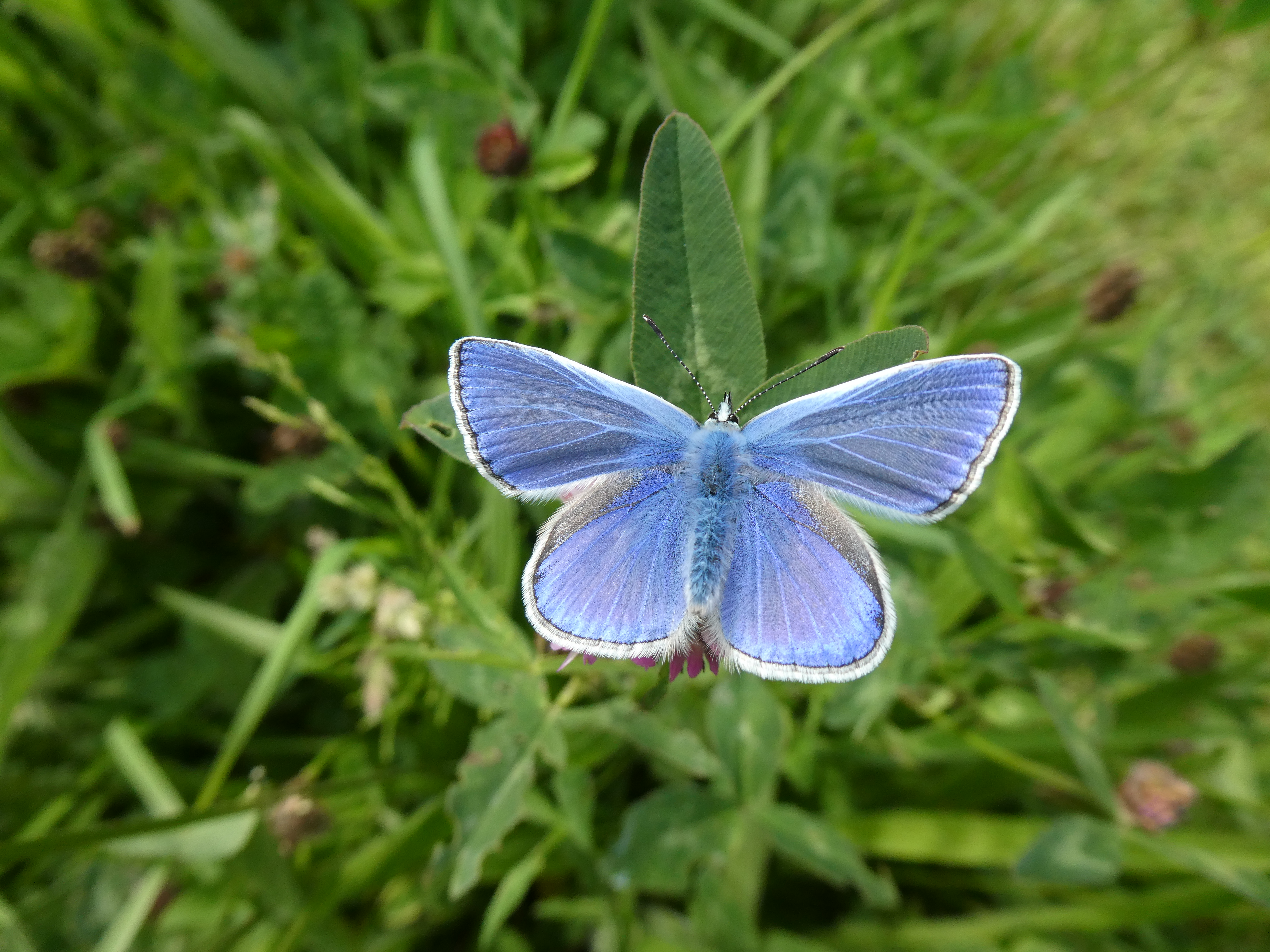 Common Blue in Jesmond Harding’s garden, County Meath. Photo © J. Harding.
Common Blue in Jesmond Harding’s garden, County Meath. Photo © J. Harding.
Conservation in Gardens
Gardens that provide both larval food plants, as well as nectar sources, had significantly higher numbers of species than those that provided nectar only. This finding is important because it suggests that butterflies can use gardens for their full life cycle and that gardens have a role to play in conservation. Growing Stinging Nettles, cabbages, Common Bird’s-foot-trefoil, Lady’s Smock and wild grasses in sunny, sheltered conditions is a great draw to butterflies and moths. Growing Alder or Purging Buckthorn, Common Holly and native ivy will enrich the species count and numbers further. One may really be inspired to go still further by offering bruised over-ripe plums or dates which Red Admirals find irresistible.
Gardens with Buddleia had high numbers of butterflies, and the plant is especially attractive to the Large White, Small Tortoiseshell, Peacock and Red Admiral.
At this point, a description of Robert Donnelly’s and Jane Doughty’s garden in Kilkenny should help to explain the extraordinary records arising from their plot. Jane points out
On two acres we grow our own fruit and vegetables along with ornamental areas too, all grown organically for the last ten years or more. We mass plant Nepeta, Verbena bonariensis, buddleias and generally select plants which are beneficial to wildlife.
One acre is managed as a meadow where we have added a sizeable pond, retained a wet area and manage the old never cultivated pasture. This area we augment with the addition of wildflowers focusing on specific foodplants for butterflies.
In addition to the records stated earlier, in 2019 the garden was visited by a Narrow-bordered Bee Hawkmoth; this is the only visit by this species to a garden reported to Butterfly Conservation Ireland.
In the past few years of the survey, 19 species have been recorded in Irish gardens. This is impressive and underscores the importance of managing our gardens for butterflies and moths not only to encourage visits by adults but to encourage breeding too. Interestingly, two gardens recorded breeding by Cryptic Wood White in 2019. This butterfly is not considered a garden breeder but Robert Donnelly and Jesmond Harding observed egg-laying in their gardens, adding greatly to the pleasure of knowing that the work put into building habitat pays off. Our gardens can and should play a role in conservation.
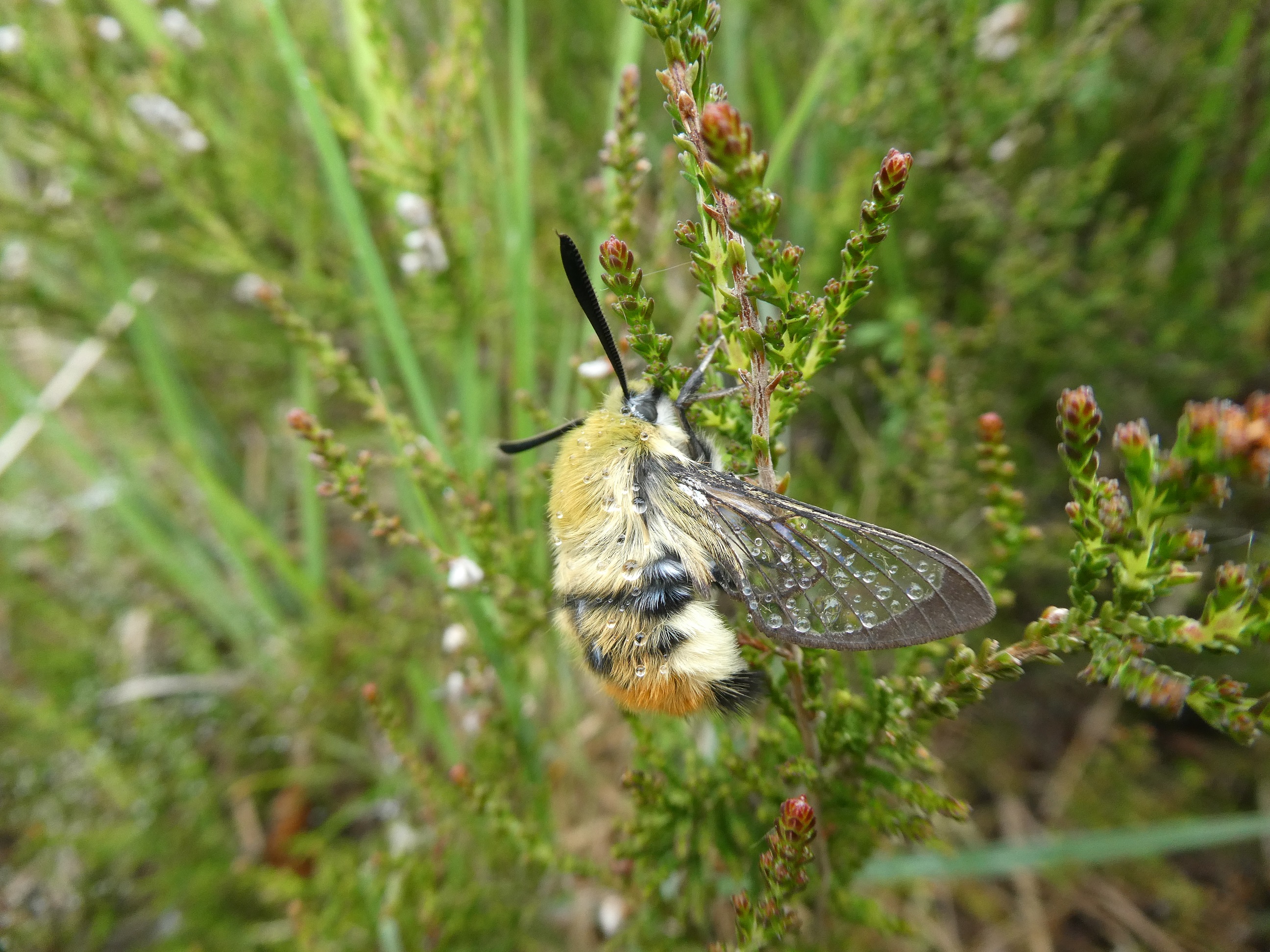 A Narrow-bordered Bee Hawkmoth visited Robert and Jane’s Kilkenny garden in 2019. Photo © J. Harding.
A Narrow-bordered Bee Hawkmoth visited Robert and Jane’s Kilkenny garden in 2019. Photo © J. Harding.
Get Involved
We hope to expand the garden recording scheme further in 2020. Our website www.butterflyconservation.ie contains information about butterfly gardening; click on the “Butterflies” tab and select “Gardening for Butterflies” for details. The survey form can be downloaded from here but if you need a hard copy please request one by emailing us at conservation.butterfly@gmail.com or by letter to Butterfly Conservation Ireland, Pagestown, Maynooth, County Kildare. If you have any doubts about the identity of any butterfly check our Gallery by clicking on the “Butterflies” tab. Thank you for taking part in the scheme and please continue your recording. Recording begins again in March and here’s hoping for a good season in 2020.
Jesmond Harding
AN INTRODUCTION TO MOTHS
Moths are generally regarded as obscure, dull and even harmful insects. Even among butterfly lovers, moths are frequently ignored. Around three-quarters of the UK population (74%) have some negative opinion of moths, with many people believing the majority eat clothes and are pests, a study has revealed. A YouGov poll for Butterfly Conservation UK revealed that 64% of people associated moths with eating clothes and one in three (33%) with being pests. Moths have long suffered an unfair reputation as the devourers of clothes despite the fact that only two out of more than 2,500 UK species are known to regularly feed on some fabrics. And rather than being pests, the vast majority of moths play important roles in the food chain and as pollinators. The research found that 17% of people thought moths were ugly and 12% believed they were scary. But some held more positive views with one in five people (21%) believing moths were important and almost a third (29%) that they were interesting. Opinions in Ireland are likely to be similar. We hope this general introduction to moths, by Philip Strickland, will create a positive impression.
About Moths
Moths are often overlooked and misunderstood, but they play a very important part in our wildlife ecosystem. They are found in just about every habitat and though numerous, they can be elusive with the vast majority of species flying at night. Ireland has over 1500 different species of moths, which we broadly break down into two groups, the macro (larger) moths (600 species) and the micros (smaller) (900 species).
Recent reports have shown a worrying decline in the numbers of moths, primarily down to the loss of habitat. These decreases in populations are not just bad news to the moths themselves, but also have worrying implications for the rest of our wildlife. Adult moths are important plant pollinators and their caterpillars are vital food items for many other species, including amphibians, small mammals and many bird species.
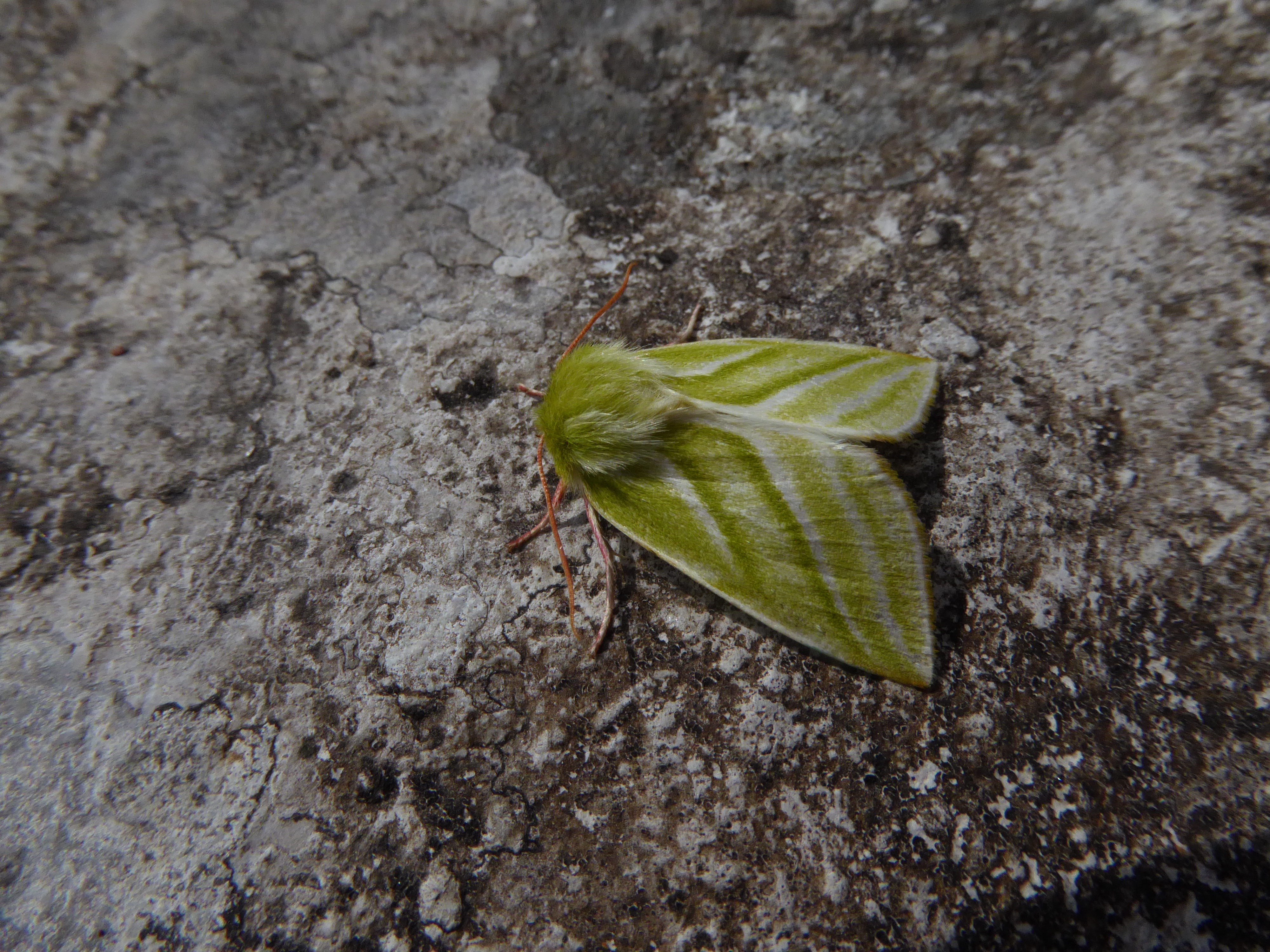 The Green Silver-lines is a macro (larger) moth. This woodland moth is also found in mature gardens holding birch or oaks. It comes to light traps. Photo © J. Harding.
The Green Silver-lines is a macro (larger) moth. This woodland moth is also found in mature gardens holding birch or oaks. It comes to light traps. Photo © J. Harding.
Finding and Recording Moths
While moths are widespread, they are sensitive to changes and this makes them particularly useful as indicator species of ecosystem health, which allows us build up a long-term picture of any changes that may be occurring.
Ways to find moths include:
By Day: Day flying moths can be captured and recorded, especially in sunny warm weather using a net.
At Dusk: Dusk can prove to be a very productive time for netting moths, especially as many of the smaller micros are on the wing at this time of the day.
By Night: The nocturnal habits of most moth species and their attraction to light allow recorders to use artificial lights in the form of a moth trap as the easiest and most popular method of catching moths. The UV light attracts the moths and they hit the veins on the trap and settle in or around it unharmed. Traps can be battery-powered or mains operated. The day-flying species are not usually found in light traps and there are also some species that do not seem to be attracted to the UV light at all.
Caterpillars: Can be looked for both during the day and at night, though night time is usually more productive. Some of the caterpillars of micro-moths are found internally between the surfaces of leaves and form a diagnostic pattern or ‘mine’ (leaf-mining).
Here are some micro-moths (photos © Philip Strickland). These moths are usually quite small but the wonders of digital photography allow us to appreciate their interesting shapes and markings.
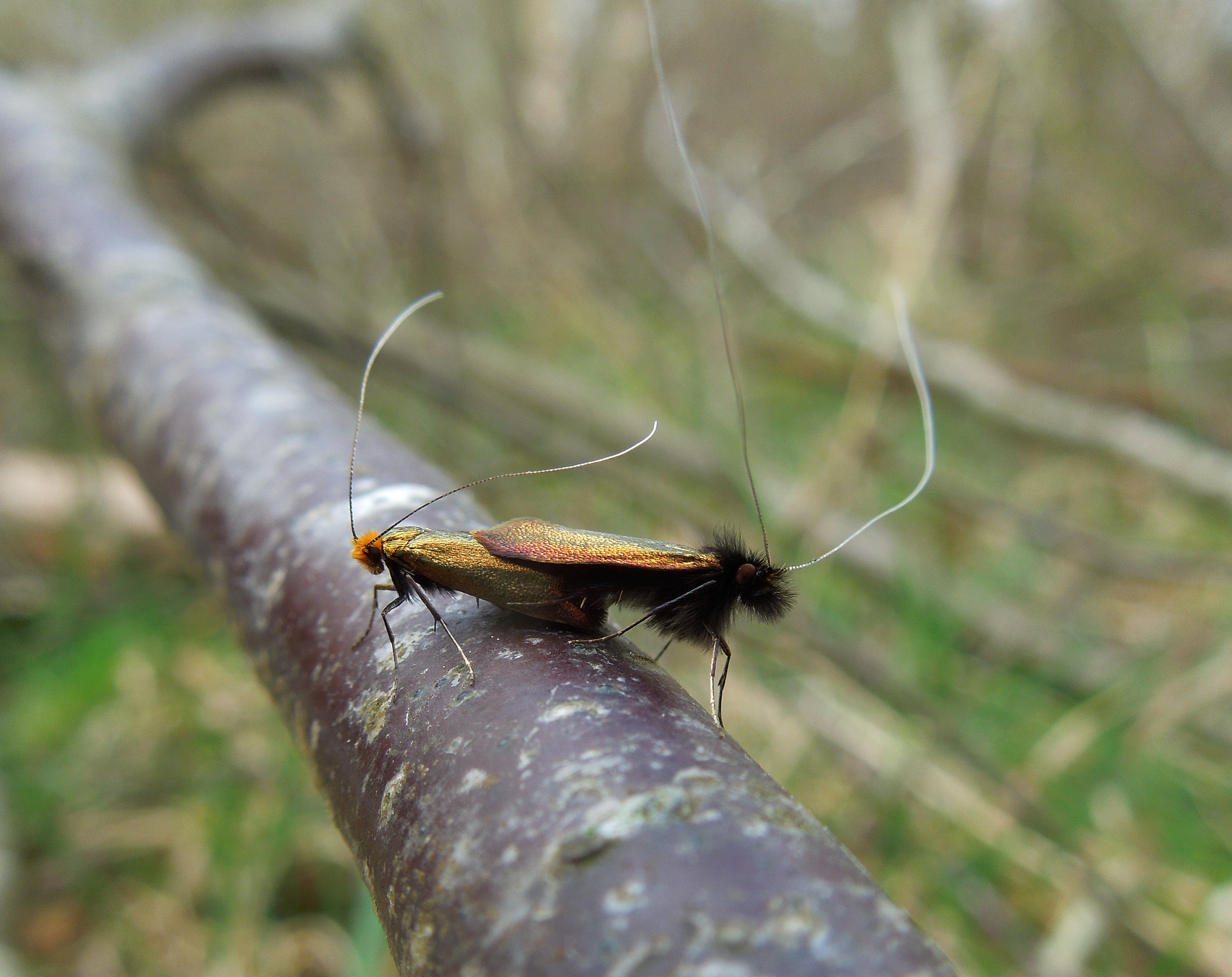 Adela cuprella in copulation: Day flying from Lullymore, Kildare. Fairly scarce in Ireland.
Adela cuprella in copulation: Day flying from Lullymore, Kildare. Fairly scarce in Ireland.
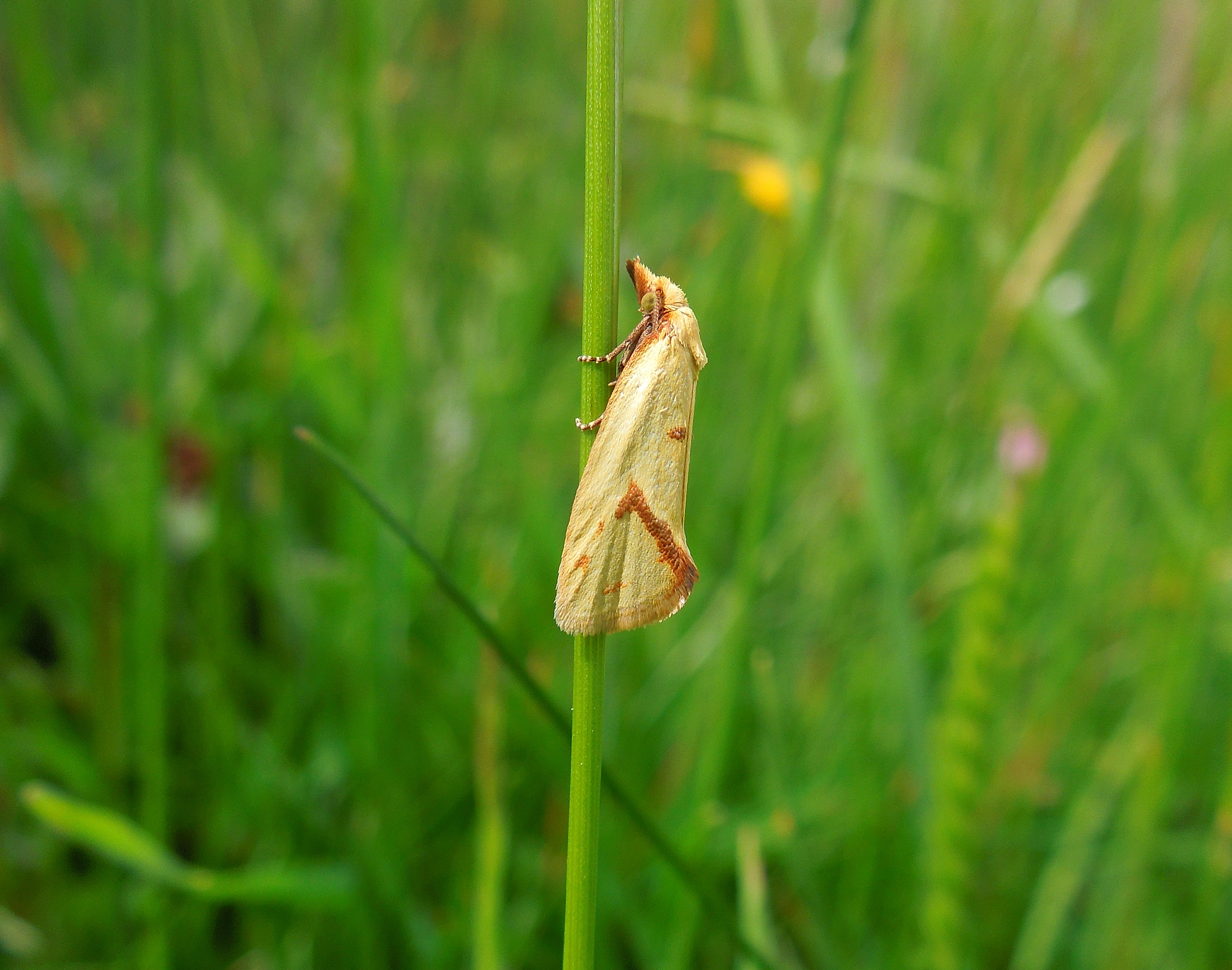 Agapeta hamana. Commonly found at dusk and in moth traps.
Agapeta hamana. Commonly found at dusk and in moth traps.
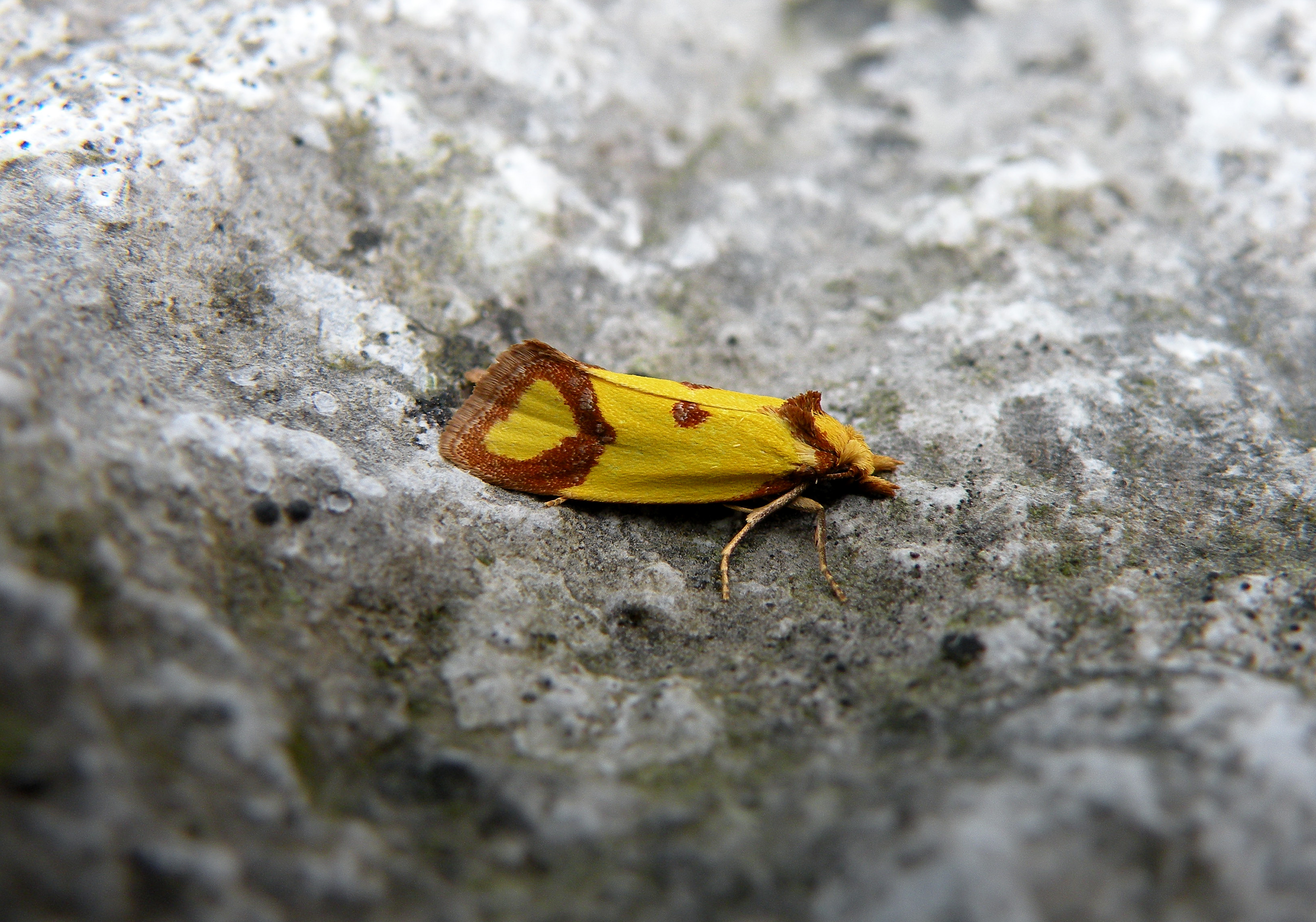 Agapeta zoegana. Local, comes to light traps. Intense yellow when freshly emerged but soon fades.
Agapeta zoegana. Local, comes to light traps. Intense yellow when freshly emerged but soon fades.
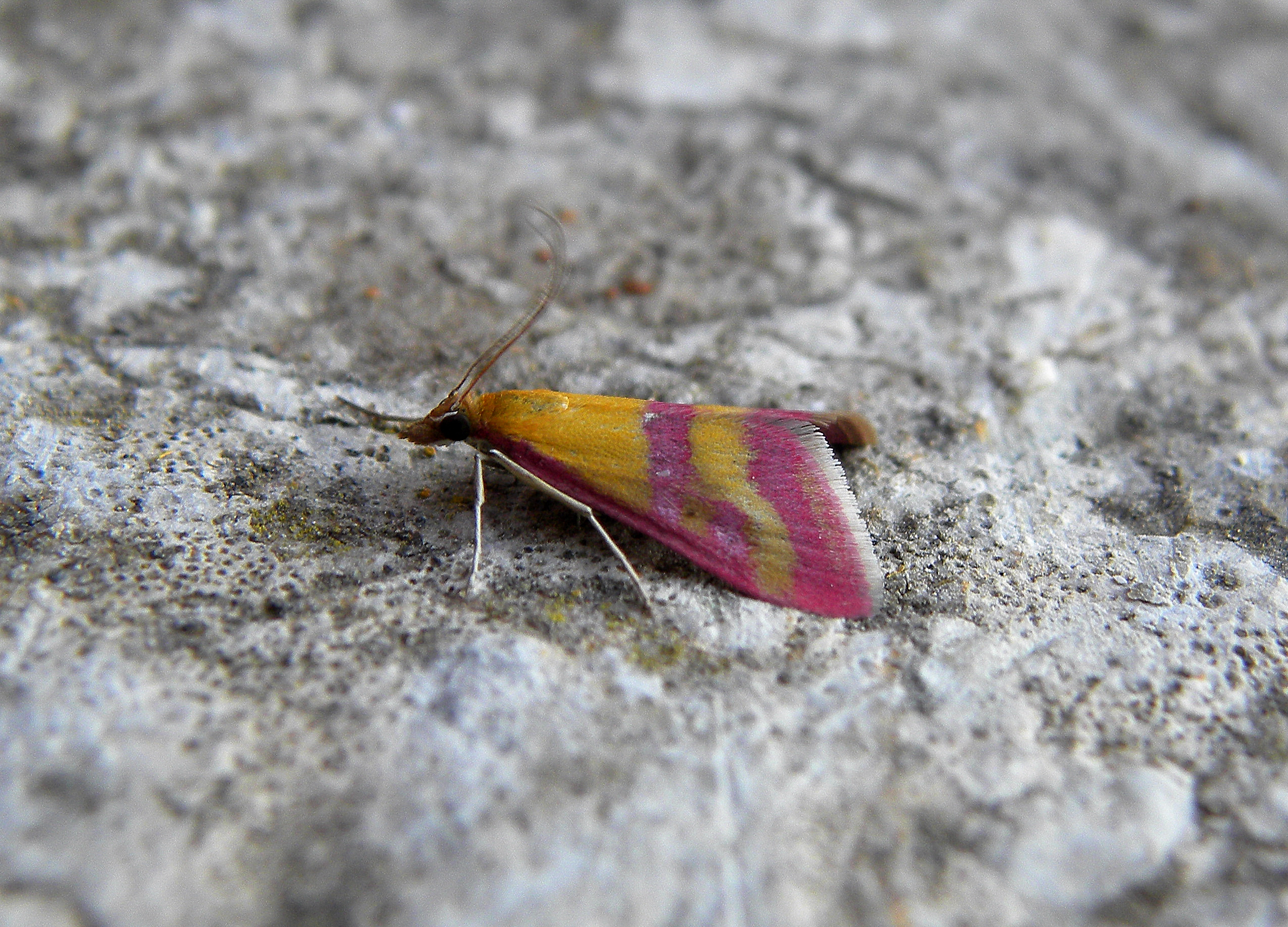 Pyrausta sanguinalis has an English name, Scarce Crimson and Gold: Another iconic species found in the Burren and at one or two other sites in Ireland. Very distinctive, it flies in daylight.
Pyrausta sanguinalis has an English name, Scarce Crimson and Gold: Another iconic species found in the Burren and at one or two other sites in Ireland. Very distinctive, it flies in daylight.
Gardening for Moths
Gardens are very important places for moths. Many of our moth species are in trouble as a result of urbanization, intensive agriculture, a general tidying up of our hedgerows, roadside verges and gardens, use and over-use of pesticides and herbicides (weed killers), all of which have many negative impacts for moths.
Any garden, regardless of size, can help moths, by providing food, shelter and safety. Several hundred species of moths may visit a garden during the course of the year. In general, moths like scrubby, unkempt wild areas, with many different native wild plants. The more caterpillar foodplants that you provide, the more species your garden will potentially support.
Adult moths need sources of nectar, but of greater importance is the availability of larval foodplants so that caterpillars can feed and reach adulthood to maintain the population. Different moth caterpillars feed on a range of different food sources such as plant leaves, flowers, wild grasses, seed pods, dead leaves, algae, roots and living wood.
Tips for Creating a Haven for Moths in your Garden
Go Native! Our Irish moth species need native Irish trees and plants to survive.
Native trees such as willow, birch, oak, hawthorn, blackthorn and poplar are great foodplants for caterpillars.
Native plants such as bramble, wild grasses, plantain, dandelion, chickweed, Stinging Nettle and Rosebay Willowherb are excellent foodplants.
Go Wild! Let nature take its course and the moths will come.
Ditch the lawnmower. Leave parts of your lawn to grow to encourage wildflowers such as clover, Common Bird’s-foot-trefoil and Common Knapweed. Day flying moths love to feed on these
Kill the weed killer! Weeds (wildflowers) are foodplants for moths and other pollinators
Freestyle It! Let nature make a house a home.
Create hiding places from predators. Leave overgrown areas and grow climbers up walls
Don’t be so tidy. Leave dead plant material, like fallen leaves to provide places for caterpillars and pupae to overwinter
Sweeten the night air. Select a variety of plants that release scent at night to create continuous blooming all season long. The best plants are Common Honeysuckle, Evening Primrose, nicotiana, Night-scented Stock, Common Jasmine, Verbena bonariensis, Buddleia and Sweet Rocket
Cut Out the Cutting! Hedges and shrubs provide food and shelter for moths during their life cycle.
Don’t cut hedges and shrubs in the growing season.
Delay cutting back hedges and old plants in flowerbeds until the late winter.
Please remember that habitat loss, not climate change is the biggest threat to our moths and butterflies.
BUTTERFLIES OF THE BALKANS
In the following article, Mike Friel describes his experiences of butterfly-hunting in the Balkans in south-east Europe. The German Chancellor Bismarck (1815-1898) famously dismissed the area as “Not worth the bones of a single Pomeranian grenadier”. Chancellor Bismarck obviously knew nothing about the Balkan’s butterfly treasures! All photos © M. Friel.
Bulgaria has the fifth largest number of butterfly species (211) among the EU member states, and unlike the top four (Italy, France, Spain and Greece), it has neither a Mediterranean coast nor an extensive mountain range. That said, it has several smaller mountain ranges, mainly concentrated in the south-west, known for their rich biodiversity. My wife and I set off to explore this area, continuing westwards into North Macedonia, then back into Bulgaria again. We travelled in a hired car for seven weeks, between June 6th and July 26th, spending some 23 of these days concentrating on butterflies. I will describe the most interesting sites we visited, with the more uncommon species seen.
Dragoman (June 9th): A one-hour drive north-west from Sofia led us to the last town before the border with Serbia. Just outside the town, there is a long karst ridge called Chelan, rising to over 1000m. The area we visited after lunch at the foot of the ridge was rich in wildflowers, with the scent of thyme filling the air. The first species I saw was Russian Heath, perched on a bush. Other notable finds were Eros Blue and Black Hairstreak. Many common fritillaries and blues darted between the flowers, making for a fine introduction to the butterflies of this region. One could happily spend two or three days looking deeper into this unspoiled area, and it would be a good starting point for a trip into Serbia.
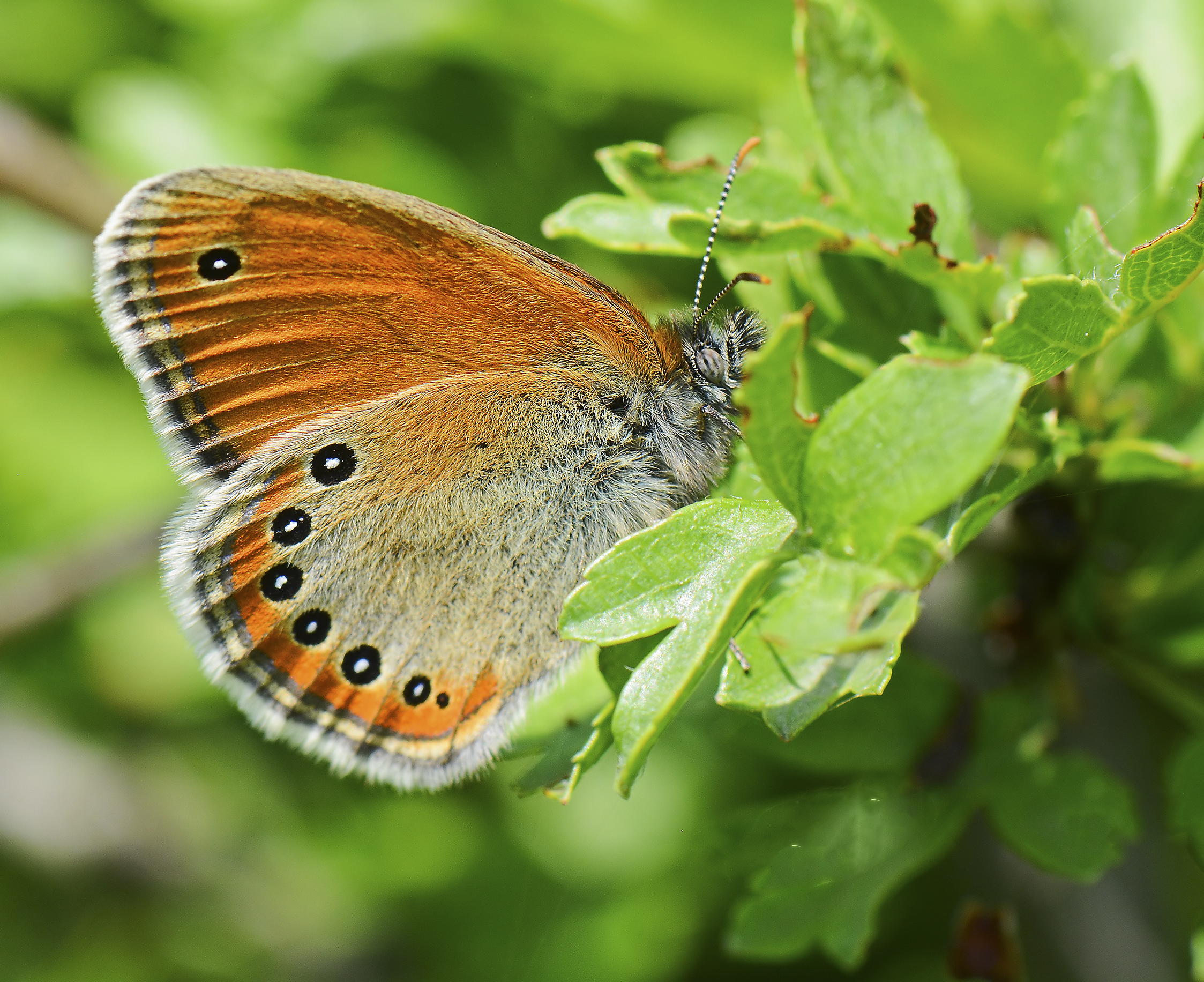 Russian Heath.
Russian Heath.
Dobrostan (June 11th and 13th): After visiting Plovdiv, Bulgaria’s second city, two hours’ drive SE of Sofia, the next stop was a high plateau in the Western Rhodope Mountains, one hour further south. Parking in the morning at an almost deserted village (and time and again we came across many signs of depopulation and emigration), I walked onto the plateau (c1200m), where the only visitors seem to be the owners of a few cows and visiting hang-gliders. To a background of calling corncrakes, I counted 21 new species for the trip in the next 4 hours, over a terrain sometimes grassy, sometimes rocky, dotted with many low trees, and again alive with wild flowers. Among the butterflies I saw were Bright-eyed and Almond-eyed Ringlets and puddling Osiris and Turquoise Blues, Pearly Heaths, Chequered Skippers and several kinds of fritillary. Most prominent of all were the large and languid white shapes of magnificent Apollos, moving from flower to flower. As I was unable to get a good shot of this beautiful Parnassian, I revisited the site in the morning two days later and was rewarded with – among others – a fine specimen feeding for about 45 minutes on two adjacent flowers, ignoring my presence. On the road back at a lower level I checked out a couple of woodland areas where more new fritillaries showed up, as well as a Safflower Skipper, Chequered Blue and my first ever Duke of Burgundy.
Devin (June 18th): In the southern part of the Rhodope Mountains, just north of the spa at Devin, a long canyon trail can be followed. More than some of the other dramatic canyons in this area, this one allows enough sunlight for flowers and butterflies to flourish. While my wife enjoyed a soak in the hot open-air mineral baths, I explored this canyon, finding Cardinal Fritillaries, Balkan Clouded Yellows, Brimstones, Eastern Wood Whites, as well as Sooty and Scarce Coppers.
Rila Valley (June 21st): Heading back northwards, we entered Rila National Park from the west. The road follows a heavily-wooded valley up towards Bulgaria’s most famous monastery. I found a track running beside the main road lined by hedgerows, where land had been partly cleared for farming but then abandoned. In the afternoon, 11 new species turned up along this track and on adjacent open ground, including more fritillaries, Purple-shot Copper, Lattice Brown, Yellow-banded Skipper and an attractive Eastern Festoon, which stayed feeding for only a few moments. Poplar Admirals are often seen in this valley, but I was not lucky on this occasion.
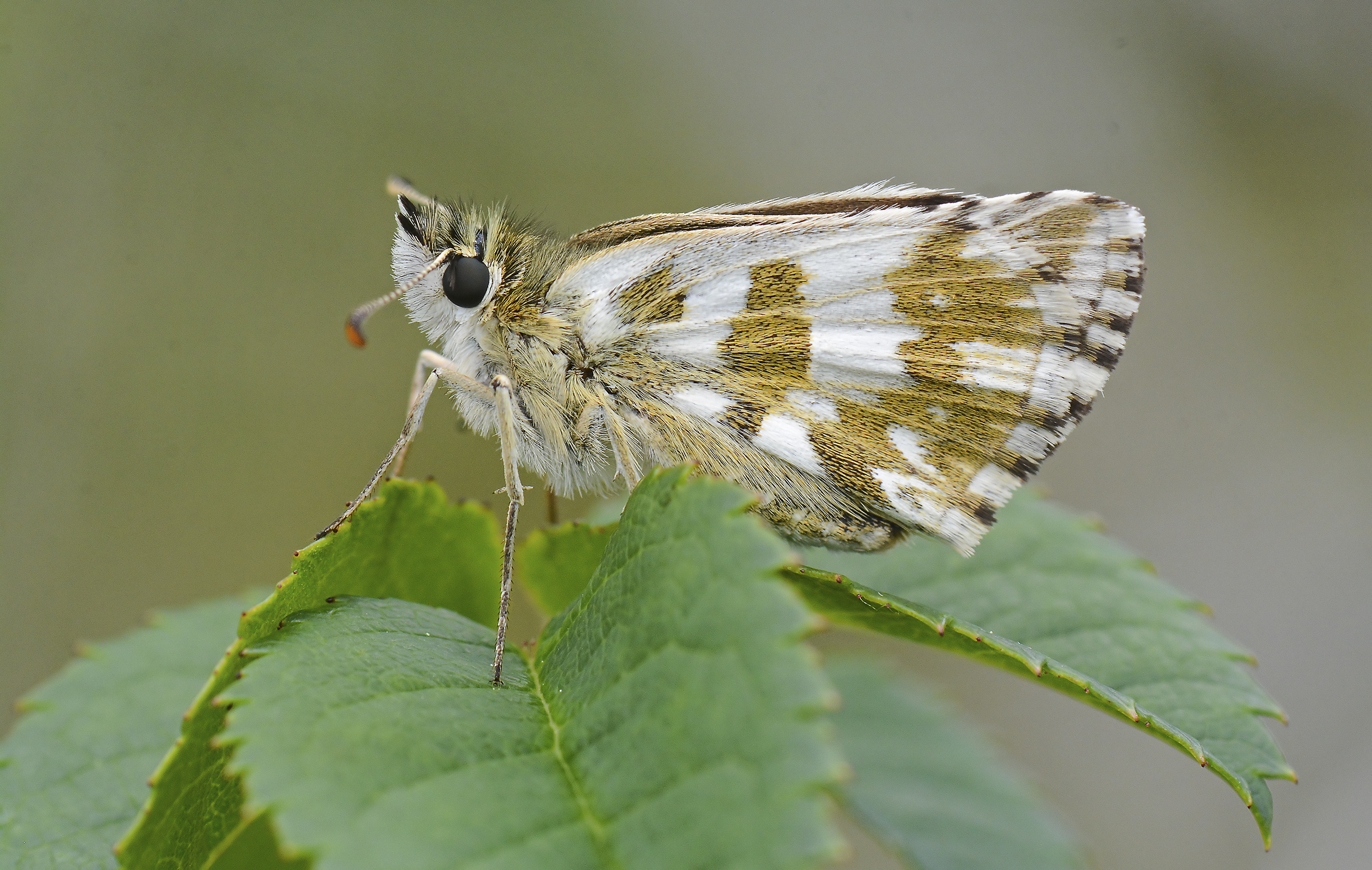 Yellow-banded Skipper.
Yellow-banded Skipper.
Pletvar (June 25th): Leaving the EU, we entered without any hassle the newly-renamed neighbour to the west of Bulgaria, North Macedonia, and were quickly struck by the more dry, rugged terrain, as well as the extent of depopulation, indicated by large swathes of abandoned farmland and empty, crumbling houses. I headed for Pletvar, just east of the town of Prilep, eager to find the country’s endemic Macedonian Grayling. On the way, in the Raec Valley, we saw a Hungarian Glider and Southern White Admiral. The next morning, I spent 4 hours in searing heat on the slopes of the Pletvar massif – a huge rocky outcrop with sparse vegetation, perfect for graylings – but it seems I was too early. I did see Woodland and Great Banded Graylings, as well as many Great Sooty Satyrs, Balkan Marbled and Mountain Small Whites, plus an Orbed Red Underwing Skipper and a Hermit back towards the Raec Valley – but no Macedonian Grayling.
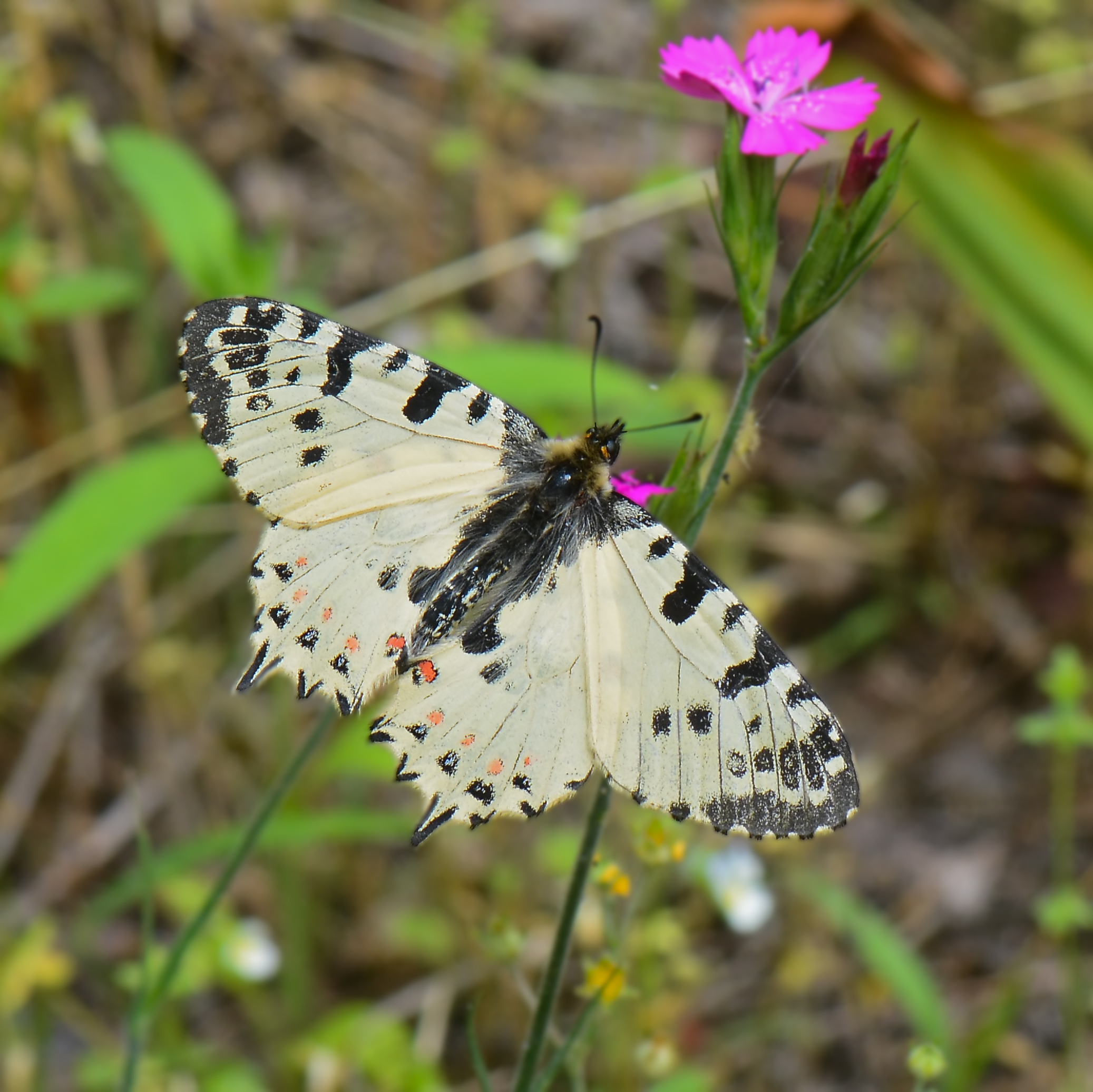 Eastern Festoon.
Eastern Festoon.
Pelester N P (June 27th): North Macedonia has three National Parks. Pelester in the south-west requires a very steep climb or 4WD to reach open meadows through the thick coniferous forests, so I just walked along the lower reaches, which were too dark to yield much except Arran Browns. I then found a rough, sunlit road running along the northern park border, and I had scarcely set foot along it when a brown shape slowly descended from the trees to rest on the road in front of me. It was skittish, but became more accustomed to my presence, allowing me decent shots of a superb Poplar Admiral, which I had long hoped to see. The road was lined with aspen trees, which – with black poplar – form the larval food plant. As I walked on, I saw a few more of this species sucking minerals from the road, but none as tame or as pristine as the first one. Further along this road (at just under 1400m), I came across Purple Emperors, an Eastern Rock Grayling, Large Wall Brown and its rarer cousin, Northern Wall Brown. Then as evening approached, I drove down a bit, and in a small open rocky patch of land found a Clouded Apollo feeding persistently on thyme flowers.
For the next couple of days, we visited the nearby Galicica National Park. This proved disappointing, as the only new species I saw were Reverdin’s Blue and Balkan Zephyr Blue. The Park is said to be very rich in butterflies, but the first day was very windy up high, while on the second day a car rally was being held, and the upper roads were closed. To compensate, we spent a pleasant three days on protected Lake Prespa, staying at the majestic Lake View Resort Hotel, for 33 euros a night, including breakfast.
Mavrovo N P (July 5th and 6th): After a detour of three days south into Albania, we travelled back via a second protected lake, Ohrid, to the third National Park, Mavrovo, in the north-west of the country. North Macedonia seems to be completely surrounded by high mountains, and the highest of all – over 2500m – are found near Trnica, where we stayed. The rocky canyon formed by the Radika river provides a rich butterfly habitat with patches of meadow surrounded by broadleaf woodland. Proceeding north up the 12km valley, I found Northern Brown Argus, Woodland Ringlet, Large Blue, Mazarine Blue and Blue-spot Hairstreak. I was allowed past the first customs post without passport, and soon came on a Camberwell Beauty feeding on the rough road – it quickly took flight. I turned round just before the border with Kosovo, where the road was very steep and rocky, but a drive further on to the Sar-Planina range might prove good for upland species, given a passport and a stronger car. On the way back down I saw Balkan Coppers, several Purple Emperors on the road, and some Apollos which came to feed on the flowers, posing peacefully.
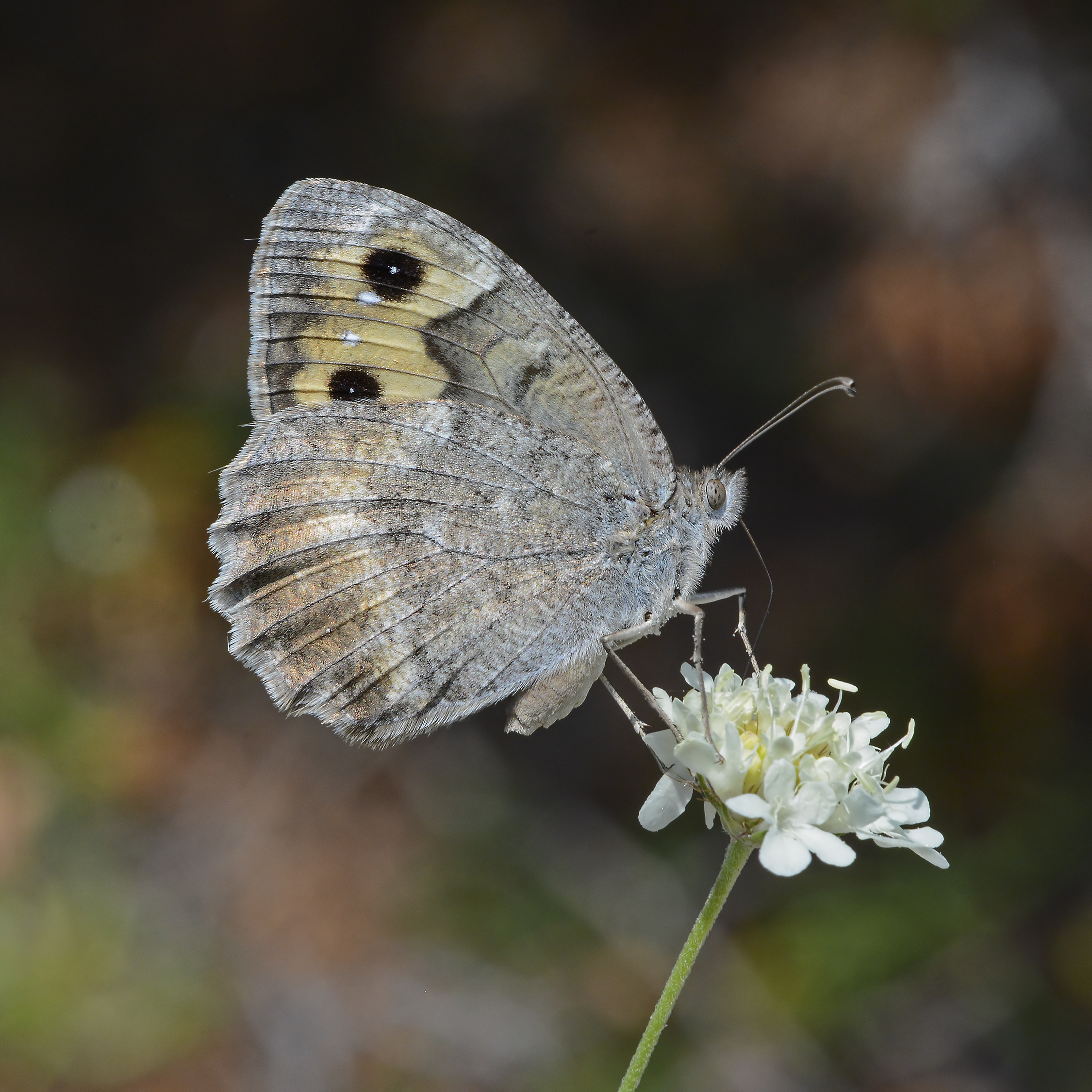 Macedonian Grayling.
Macedonian Grayling.
Pletvar (July 8th): Not one to be left empty-handed on the Macedonian Grayling front, I returned to the Pletvar massif, as this critically-endangered species normally flies in July and August. Once more, on the hottest of mornings, I traipsed the rocky slopes for three hours, enjoying excellent views of the ungainly 4-inch wide antlions (Palpares libelluloides) fluttering around, and finding Ripart’s Anomolous Blue, but no MG. Finally, after a picnic lunch, I tried one last steep rocky slope, and to my delight found the much sought-after Macedonian Grayling, in fact, half a dozen of them, all flitting around the stones in search of nectar on the occasional flower, or chasing each other off. It was great to see them in such good condition, especially as I like graylings of any kind. The way they seem to suddenly disappear really brings out the hunter in me with the camera.
Gotse Delchev (July 15th and 16th): After heading south along the Vardar valley which bisects the country, one final, mountainous stop in North Macedonia was Konsko, near the border with Greece; this site only produced one new species, Meleager’s Blue. Then we spent 3 days at Lake Kerkini in northern Greece, before returning to Bulgaria, avoiding the Kresna Gorge, as I did not want to see the motorway being built through it. Our next butterfly stop was Gotse Delchev, a town well placed for trips into the nearby Pirin mountain range, a National Park. I first headed west and tried to climb Mt Orelek, but thick clouds descended to ground level and I had to turn back, only seeing Large Ringlets and a Slender Scotch Burnet. Then I moved to nearby Lipovi Povadi, a series of small meadows set among coniferous woods at about 1400m. The clouds cleared and I found a couple of undisturbed meadows full of coppers, some fritillaries, an Oberthur’s Grizzled Skipper, Silver-studded and Idas Blues plus Forester and 5- and 6-spot Burnet moths.
 Pletvar Massif, the only area in the world for the Macedonian Grayling
Pletvar Massif, the only area in the world for the Macedonian Grayling
The following day I headed one hour south-west to Paril near the Greek border and walked up the trail to the base of Mt Slavyanka. Near the huts at 1000m there was open rough terrain with many grasses and shrubs. Here, as the clouds cleared somewhat, I found, among more common species, a Large Grizzled Skipper. On the way back, an old friend, the Gatekeeper, emerged to pay his respects from a hedgerow.
Rila Heights (July 18th): We drove a very scenic route back north, ending up at the ski resort of Borovec, on the north-eastern edge of the Rila National Park. There we checked in to a beautiful boutique hotel with gym, sauna, swimming-pool and breakfast, all for 35 euros (it being low season). The next morning, we took the adjacent cable-car up 1000m to about 2350m, where a rough but flat trail led across a landscape clothed in grasses, very low pines and dwarf junipers. At the start of this trail in grassy areas we saw many Small Pearl-bordered Fritillaries on the carpets of alpine flowers. Walking along the trail, which climbers take on the way to Bulgaria’s highest peak, Musala (2925m), I saw the pines slowly change to junipers. As I sat down for lunch, I noticed a flash of grey arise from a bush nearby. Two butterflies were dogfighting, and they soon returned to rest on opposite sides of the low circular juniper. Both were male Cynthia’s Fritillaries, a handsome montane species endemic to Europe and found only in the Alps and the Rila and Pirin Mountains of Bulgaria. They continued to spar for about ten minutes, with several rests on the bush, before going off, probably in search of females, though I was unable to locate any of these. Feeling very pleased to have seen this uncommon fritillary, I walked on as far as Grantar, the first tarn at the foot of Musala, seeing on the way Eastern Large Heaths and Water Ringlets, as well as a viper (Vipera berus bosniensis) crossing my path. The tarn area is said to be good for Balkan Fritillaries, and I believe I caught one on camera by chance, though I cannot be positive about this. But as I returned to the hotel, I simply could not erase the image of the Cynthia Fritillaries from my mind – it was a magical moment.
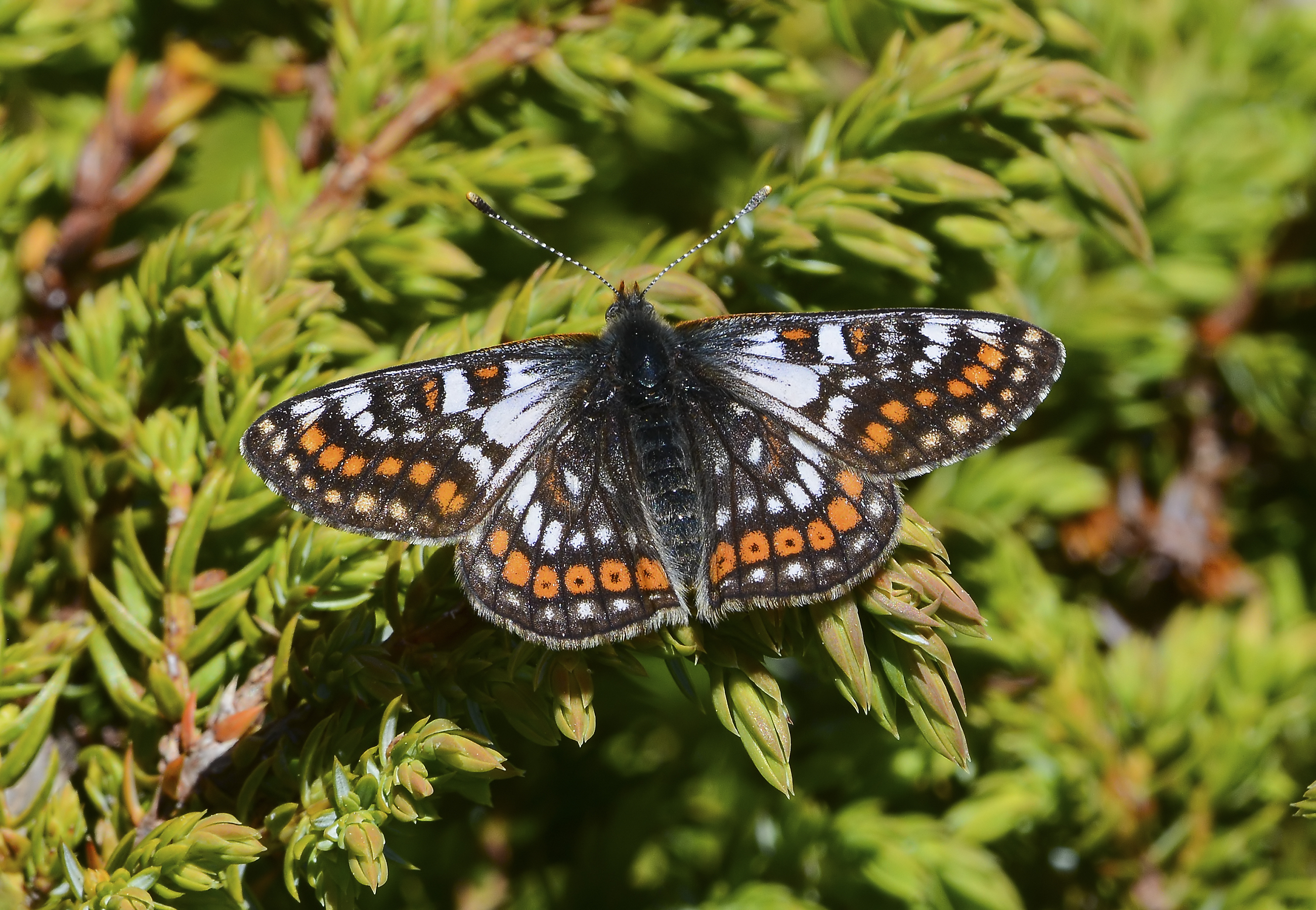 Cynthia Fritillary.
Cynthia Fritillary.
Milanovo (July 22nd): Our road trip was drawing to a close, and we spent the last week in or near Sofia. My final butterfly outing was north of the city along the Iskar Valley to the edge of the Vraca Nature Park. I explored the area along the road between Lakatnik and Milanovo, without entering the Park itself. Now, in late July, the broad hill meadows here held fewer butterflies than they would have in May or June. However, I found some more species new for the trip, tucked away in rocky or bushy areas. These included a Map, Common Glider, Oriental Meadow Brown, Lulworth Skipper, some Adonis and Eastern Short-tailed Blues and many Dryads.
By the end of the 4000 km trip, I had seen 120 species, of which 53 were new to me. My overall impression of the region was of villages bordering often on underutilised land, ideal for re-colonisation by wildlife. Roads are well-maintained and fairly empty, often past spectacular mountain scenery, with a profusion of wildflowers. The weather was mostly cool and sunny (while many other parts of Europe were sweltering), though it became hotter in North Macedonia, then cloudy with some rain in Bulgaria in July. The people we met were hospitable, especially the older ones, often living in isolation, who welcomed a chat in broken Russian. There are many other good butterfly sites that we did not visit, and I would like in future to check Serbia and Northern Greece, known for many interesting species.
Practicalities: There are flights direct from Dublin to Sofia, or via Stansted to Plovdiv. Apart from the first stay, it is better to just check in to accommodation on arrival in a town, as you will seldom if ever find it full in either country. I began by using AirBnb, and had my account hacked in the process of extending our initial stay in Sofia (the 2500 euros stolen was eventually refunded with great hassle). So subsequently we just checked in on arrival, or, for the final stop in Sofia, used www.booking.com, paying on arrival. We had an excellent car rental through www.hiremycarbg.com. The manager, Danny, even came to pick up the faultless small car from the airport at the end, though we’d started the rental in the city centre. She only charged 15 euros a day, and we had green card cover for all neighbouring countries. If you want to enjoy food, drink and lodging at less than half of what you pay at home, these two countries fit the bill. Apart from this, you will find a wealth of cultural attractions and beautiful scenery. If I had to highlight just two of the places we visited, they would be Dobrostan in Bulgaria and the Pletvar Massif in North Macedonia. I could happily spend a whole trip based in either of these.
Useful websites: www.wildechotours.com
www.bulgariatours.co.uk
ROYAL CANAL CITIZEN SCIENCE PROJECT
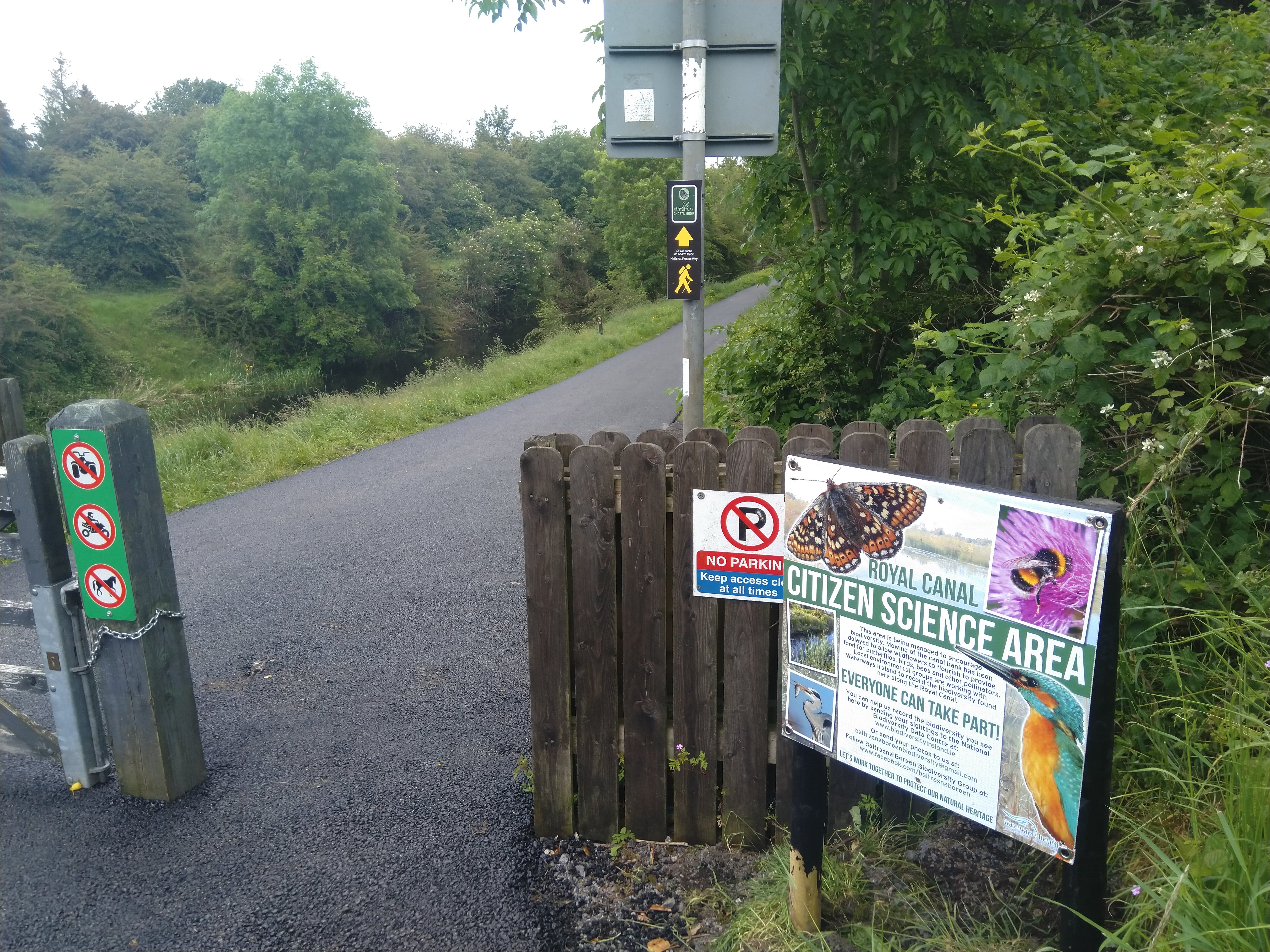 Royal Canal, Baltrasna. Photo © R. Duggan.
Royal Canal, Baltrasna. Photo © R. Duggan.
In the following article, Butterfly Conservation Ireland’s Facebook manager, Richella Duggan, describes an exciting discovery and butterfly project on the banks of the Royal Canal just outside Mullingar, County Westmeath.
Living in Mullingar I’ve witnessed the development of two major ‘Greenway’ amenities in County Westmeath over the last ten years or so. The Royal Canal Greenway, which runs from Dublin to Longford – passes within 5 minutes’ walk from my front door. Just west of the town centre – the canal path meets our second – more recently developed greenway called ‘The Old Rail Trail’ – which stretches 42km from Mullingar to Athlone, tracing the old Great Western Railway track across the middle of rural Westmeath. The development of these types of amenities can be controversial as they have the potential to negatively impact existing areas of important habitat. The proposal by Waterways Ireland to ‘upgrade’ the beautiful grassy sections of the Barrow Way into a hard-surfaced ‘Greenway’ was one such development, which was refused permission by An Bord Pleanála in April 2019 – over concerns about the impact it would have on the Barrow path Special Area of Conservation.
I have fond memories of what it was like to walk along the Royal canal banks around Mullingar and the old rail trail – prior to their redevelopment – when they were both covered in long grass, briars, scrub and wildflowers. They were overgrown and abandoned but with patches of nice wildflower habitat. These days there are fewer and fewer places where people can get access to the kind of wild solitude that these old paths offered. Now that they are developed – what was once ‘off the beaten path’ has become the well-trodden and well-cycled greenways of Westmeath. The traffic on both routes increases year-on-year – although relative compared to other more scenic paths such as the Westport-Achill and Waterford Greenways, they are still relatively quiet.
Of course, I can see the overall advantages of having some developed pathways. I enjoy cycling myself and my mother is a wheelchair user, so I do appreciate that we are very lucky to have unfettered access to safe, off-road, quiet, flat walking paths and over the last few years we have made good use of both routes during the summer months. We prefer to drive out of Mullingar town centre to one of the many different access points within a few miles of the town – to park the car and then decide on whether to walk east or west to explore different stretches of the routes – which vary considerably in terms of the habitat and vegetation on the path verges and the surrounding countryside.
Some parts are more interesting than others. Some areas are considerably dull. There are long stretches of both Greenways that offer little to distract or entertain the passing walker or cyclist. So much of Westmeath is intensively farmed – with hedgerows cut so severely they resemble low brick walls. Or worse still, hedgerows have been removed entirely. The sections of the Royal Canal paths that pass through towns like Mullingar are bordered by neatly maintained grass verges, mowed on a regular basis and of little interest to anyone seeking an encounter with nature.
Since we discovered it, one of our favourite walks is to follow the canal east from Baltrasna Bridge through the townland of Clongawny to an area called ‘The Downs’, where the surrounding countryside is comprised of scrubby fields with pockets of gorse, small clumps of trees with mature willow, holly, elder and hawthorn and a few patches of uncut bog. In summer in Clongawny you will hear the cuckoo and the songs of blackcaps, willow warblers, sedge warblers, reed buntings, stonechats, meadow pipits and even the skylark – sounds that are no longer heard in much of the wider countryside.
Notwithstanding the area’s relative wildness – it was still quite a surprise when my mother and I spotted a Marsh Fritillary at Clongawny in June 2018. On one of our frequent visits to the area during that wonderful summer, we spotted – at first just a single individual nectaring on Common Bird’s-foot-trefoil at the edge of the footpath. While trying to get a photograph on my phone as proof of this unlikely record – I spotted another three! As we walked on, we started to keep count – and our final tally that day was an astounding 30 Marsh Fritillary. The epicentre of the colony turned out to be a long, low unfenced area of wet grassland which stretched for about 280m to the right of the canal path. It was puzzling because, while there are several well-recorded Marsh Fritillary sites in Westmeath, we had never encountered them in this area before. Either we overlooked this significant population, or it was newly established.
Subsequent enquiries to Cormac McCarthy at Waterways Ireland and to our local ranger at the National Parks & Wildlife Service confirmed that neither organisation had any previous records of Marsh Fritillary at this site. Cormac suggested I contacted local wildlife activist Lesley Whiteside to see if she could shed any light on the history of this site. Getting to know and work with Lesley has turned out to be an even luckier discovery than finding the Marsh Fritillary.
For years, Lesley has been carrying out tremendous work locally to record and conserve butterflies and other wildlife. She established the Baltrasna Boreen Biodiversity Group – a voluntary organisation with an impressive array of ongoing projects based around the canal banks in Baltrasna and adjacent townlands. Their most significant undertaking is the ongoing restoration and management of an old, woodland path along the ‘High bank’ – which is a really lovely mixed woodland on an elevated section of the canal bank between Baltrasna and the N52 bridge. As well as mixed native trees, the high bank has several patches of common spotted orchids, pyramidal orchids, cowslips, primroses, kidney vetch, bird’s foot trefoil and other wildflowers – and butterflies like Holly Blue, Dingy Skipper and Silver-washed Fritillary have been recorded there over the last few years. Most of the manual labour on the High bank project has been carried out by volunteers under the direction of Lesley and her son Andrew. The group have erected nest boxes and insect hotels and planted a community orchard of fruit and nut trees. They conduct monthly summer walks and talks to increase awareness and appreciation of the importance of the habitats and wildlife in the area. The group has established good working relationships with Westmeath County Council and Waterways Ireland, who have supported several of the projects carried out to date.
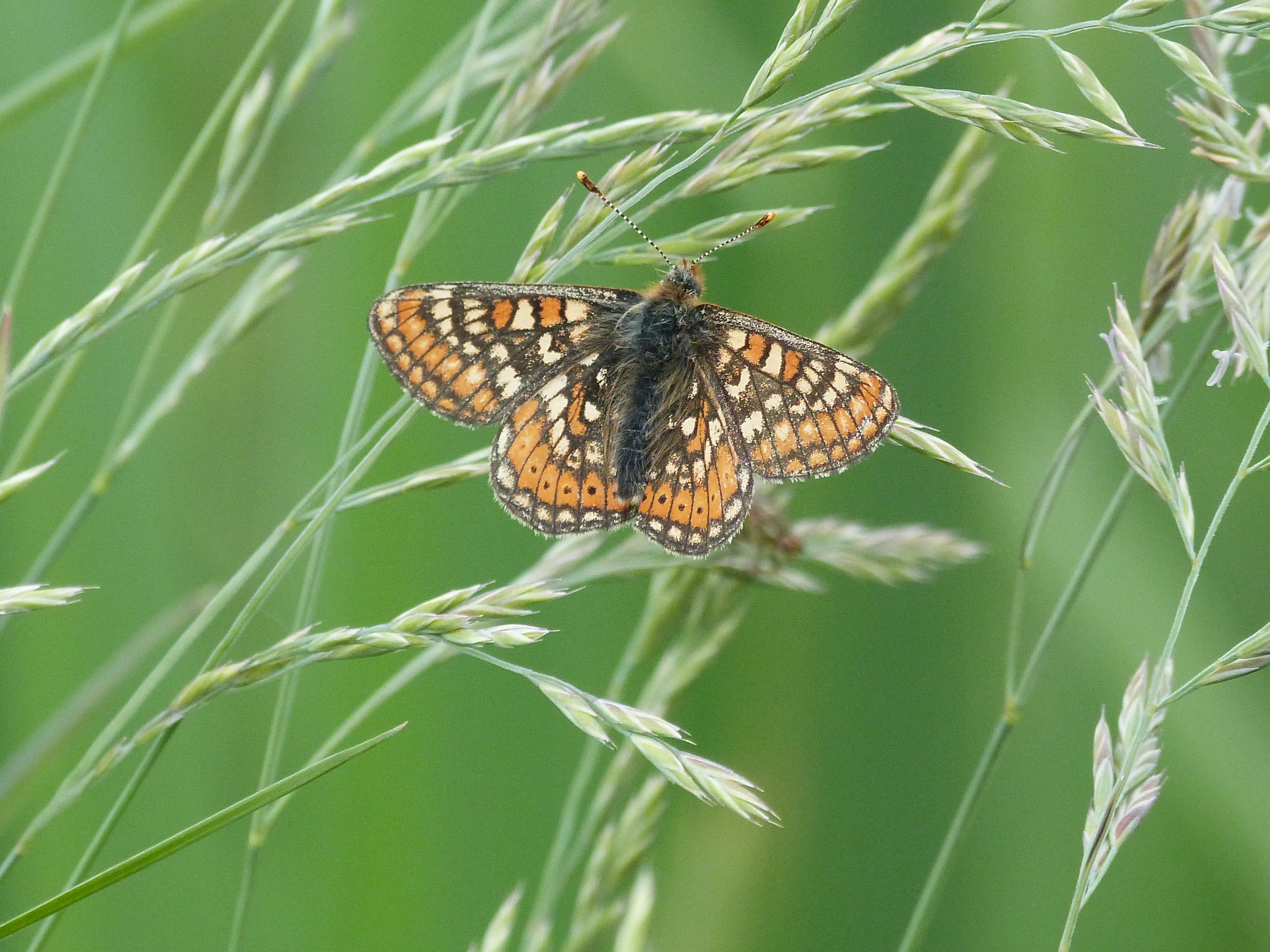
Marsh Fritillary Clongawny 3rd June 2018. Photo © R. Duggan.
Lesley and Andrew also take part in the Irish butterfly monitoring scheme. However, their butterfly transects on the canal stopped about 50 metres short of where we found the Marsh Fritillary at Clongawny – so the news of the discovery was a complete surprise for them too. Following a meeting with Cormac McCarthy of Waterways Ireland it was agreed that no further mowing of the canal bank would take place in the area that summer and Butterfly Conservation Ireland agreed to provide advice and support with monitoring the population. We carried out a larval nest survey a few weeks later in August and recorded a total of 111 nests– an extraordinary number for a site of just less than half a hectare.
In 2019 we continued to work together on the Royal Canal site and have extended the collaboration into a ‘Citizen Science’ project. The initial aim of the project was to engage local volunteers to undertake long-term monitoring of the Marsh Fritillary and to determine what management might be necessary to maintain and protect the site into the future. That has now been expanded to include recording wildflowers, birds, moths, dragonflies, bumblebees, solitary bees and whatever else visitors spot as they travel through the project area. Signage erected by Waterways Ireland provides information about the project and encourages people to take part by submitting their own records to the National Biodiversity Data Centre.
In a very welcome and significant development, Waterways Ireland agreed again not to mow the bank until the end of July 2019 – for a 5km stretch between the N52 bridge and The Downs. As the summer progressed, the mowing was actually delayed further until September. So, for the first time in a long time – all wildflowers in the project area will have had the opportunity to set seed. This is likely to improve the wildflower diversity in time – but already in this first year we’ve noticed that bird species such as goldfinch, linnets, Bullfinch and Meadow Pipits benefited from a long buffet of the seed heads of dandelion and Ribwort Plantain. It was a real treat to walk along the canal path and see small flocks of songbirds flitting in and out of the verges feasting on the seed bonanza. Later in the summer, when most of the early wildflowers had died back, our project area was still covered in knapweed flowers – which provided nectar for the influx of Painted Lady butterflies which occurred in July and August.
Volunteer effort and citizen science are at the heart of the project. Since the project began activities carried out in include –
• volunteer surveying of the Marsh Fritillary larval nests in late summer 2018 and 2019.
• scrub clearance days to limit the encroachment of willow and canary reed grass on the site
• the discovery by Lesley of a second smaller population of Marsh Fritillary at Great Down which is also within the project area.
• the discovery of several rare species for this part of Westmeath including Skullkcap (wildflower), Fir Clubmoss (plant), Holly Blue butterfly (not previously recorded in this area) and Tortoise Shieldbug (the first record for Westmeath).
• a butterfly walk and talk in June 2019 led by Jesmond Harding of Butterfly Conservation Ireland to see Marsh Fritillary on the wing.
• clearance of scrub on the high bank with volunteers from Westmeath Branch of Birdwatch Ireland and Butterfly Conservation Ireland to create suitable conditions for wildflowers, butterflies and other pollinators.
New projects goals for 2020 include
• the establishment of a new butterfly monitoring transect at Clongawny and Great Down which will monitor the adult Marsh Fritillary butterflies and other important species such as the Small Heath over the long-term. A panel of local volunteers will be trained in butterfly identification and monitoring skills.
• the implementation of a Smartphone project which will enable visitors to the project area to identify the birds, butterflies and wildflowers via their phone – in order to develop their identification and recording skills.
While this project is still in its infancy, it is already showing the importance of the banks of the Royal canal as a corridor for our wildlife and that there is much to discover about the diversity of species that depend on its various habitats. While the development of the greenway has resulted in a significant increase in the numbers of walkers, runners and cyclists using the paths of the Royal Canal, I’d like to believe that these visitors are seeking more than just a good path surface on a flat, safe route. We may not have the dramatic scenery of some of the other Greenways in Ireland but perhaps we can offer those that travel along the way the opportunity to experience the joys of wildflowers, butterflies and birdsong – while at the same time, ensuring that the area is managed and maintained in such a way that these habitats continue to be a haven for the many species that live there.
Keep in touch with our project updates on – https://www.facebook.com/royalcanalcitizenscience/
BUTTERFLY CONSERVATION IRELAND ANNUAL REPORT 2019
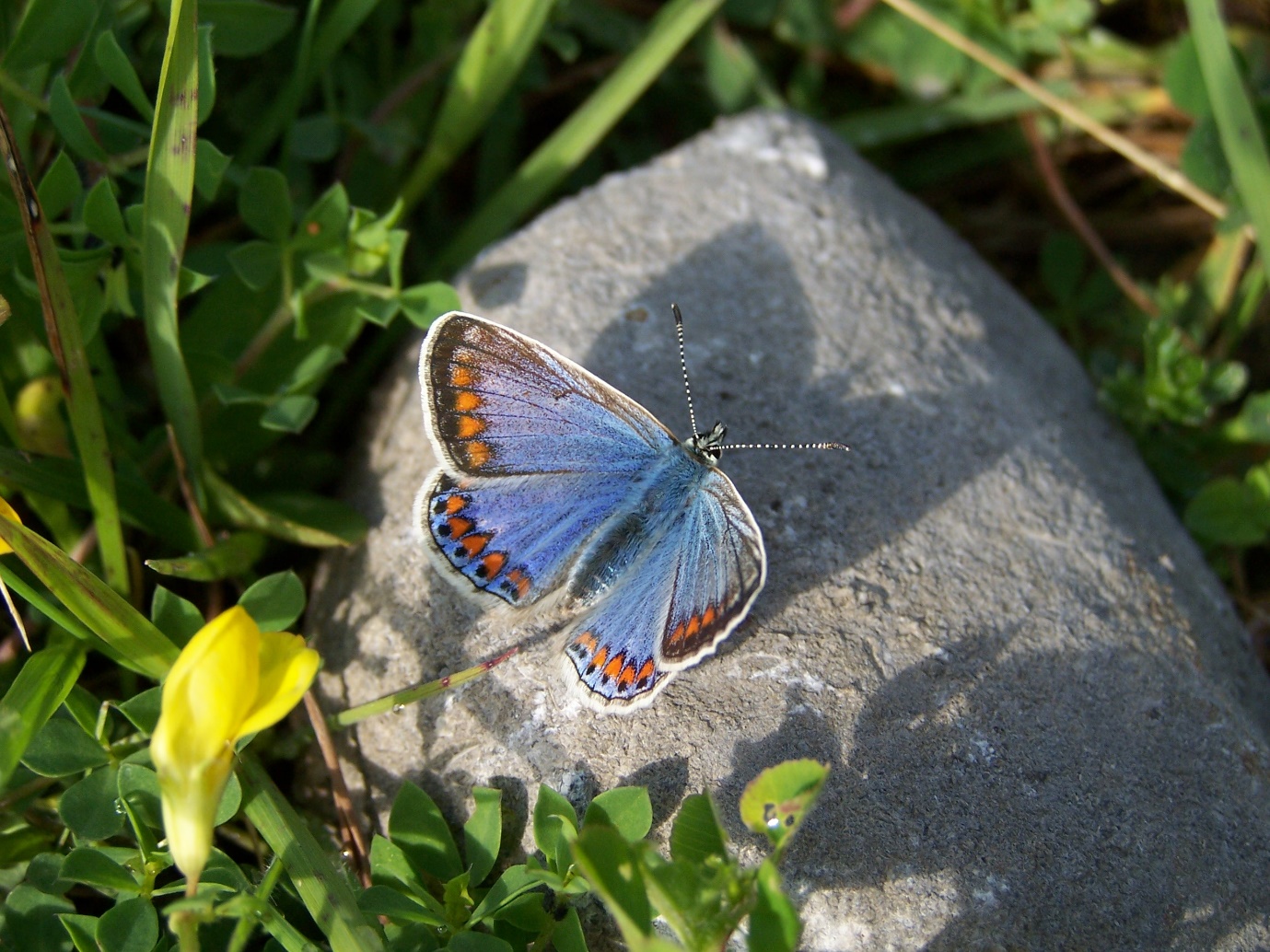 Common Blue. Photo ©J. Harding.
Common Blue. Photo ©J. Harding.
BUTTERFLY CONSERVATION IRELAND is a company limited by guarantee. Registered in Ireland No. 451571.
BUTTERFLY CONSERVATION IRELAND is a charity. Registered Charity no.: 20069131.
CONTACT DETAILS:
By email: conservation.butterfly@gmail.com.
By Post:
Butterfly Conservation Ireland,
Butterfly House,
Pagestown,
Maynooth,
County Kildare.
By phone: 01-6289901.
Website: https://butterflyconservation.ie/wp/
Facebook: https://www.facebook.com/ButterflyConservationIreland/

